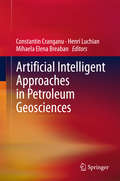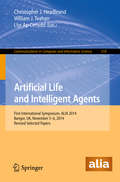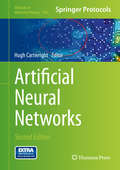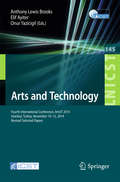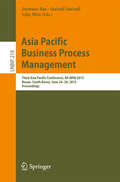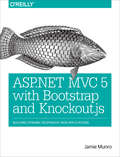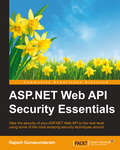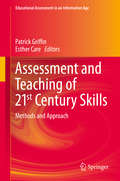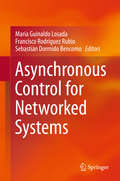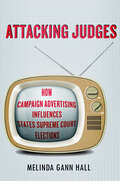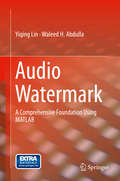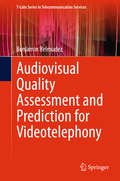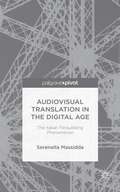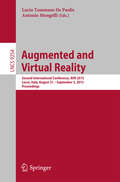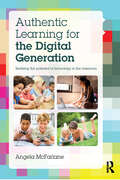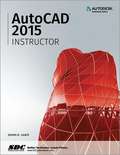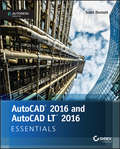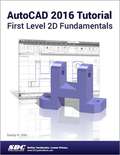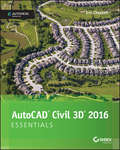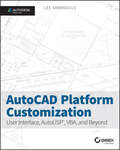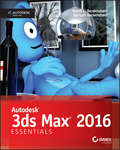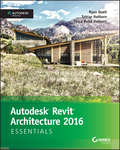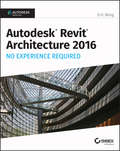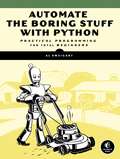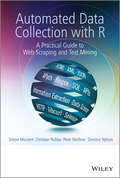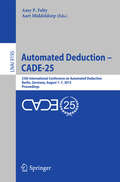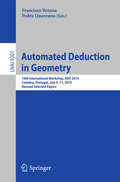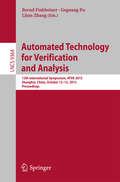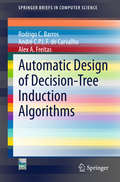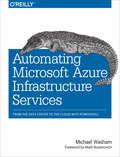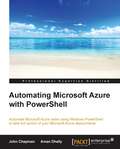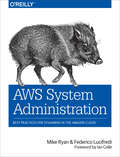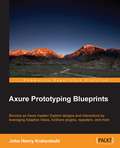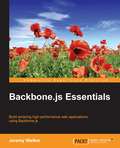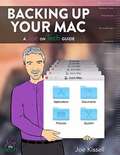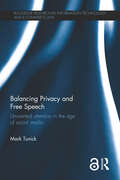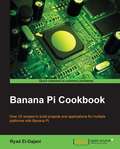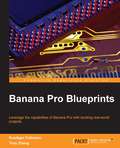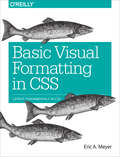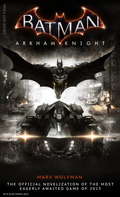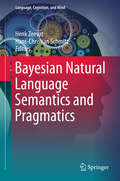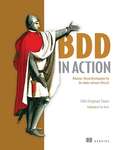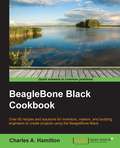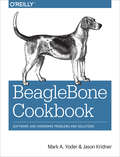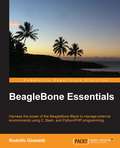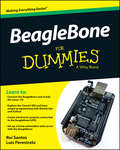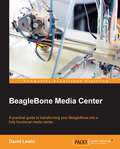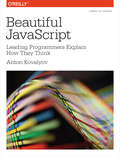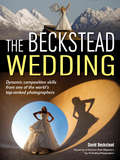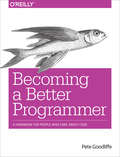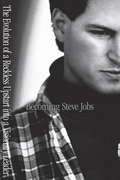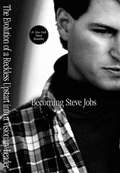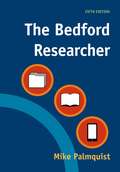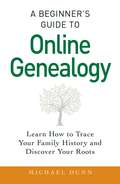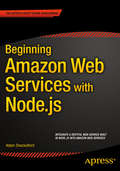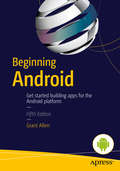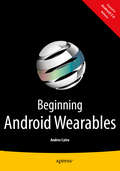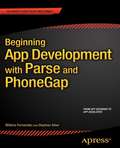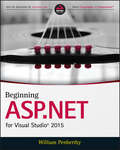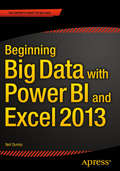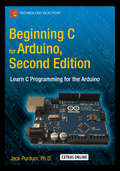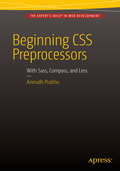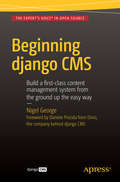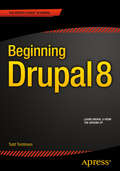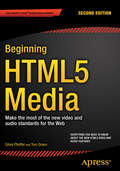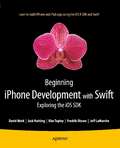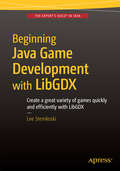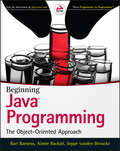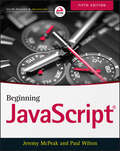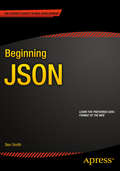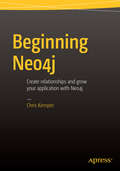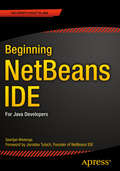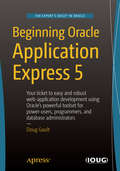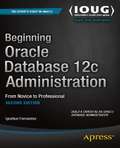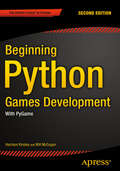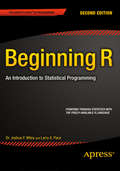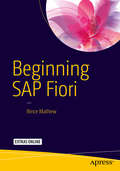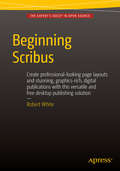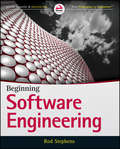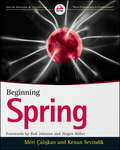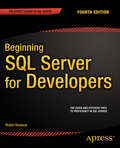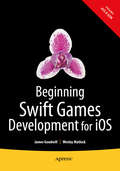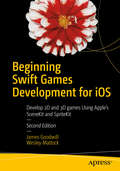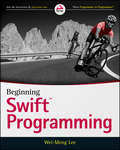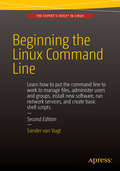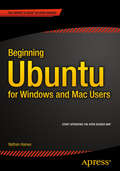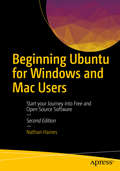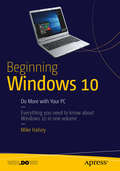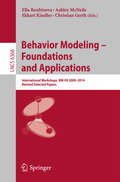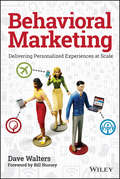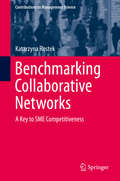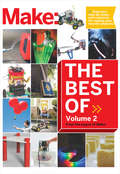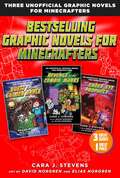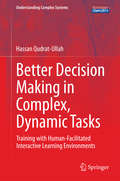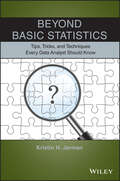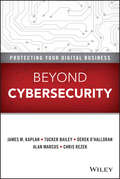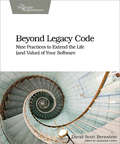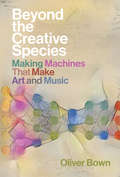- Table View
- List View
Artificial Intelligent Approaches in Petroleum Geosciences
by Constantin Cranganu Henri Luchian Mihaela Elena BreabanThis book presents several intelligent approaches for tackling and solving challenging practical problems facing those in the petroleum geosciences and petroleum industry. Written by experienced academics, this book offers state-of-the-art working examples and provides the reader with exposure to the latest developments in the field of intelligent methods applied to oil and gas research, exploration and production. It also analyzes the strengths and weaknesses of each method presented using benchmarking, whilst also emphasizing essential parameters such as robustness, accuracy, speed of convergence, computer time, overlearning and the role of normalization. The intelligent approaches presented include artificial neural networks, fuzzy logic, active learning method, genetic algorithms and support vector machines, amongst others. Integration, handling data of immense size and uncertainty, and dealing with risk management are among crucial issues in petroleum geosciences. The problems we have to solve in this domain are becoming too complex to rely on a single discipline for effective solutions and the costs associated with poor predictions (e. g. dry holes) increase. Therefore, there is a need to establish a new approach aimed at proper integration of disciplines (such as petroleum engineering, geology, geophysics and geochemistry), data fusion, risk reduction and uncertainty management. These intelligent techniques can be used for uncertainty analysis, risk assessment, data fusion and mining, data analysis and interpretation, and knowledge discovery, from diverse data such as 3-D seismic, geological data, well logging, and production data. This book is intended for petroleum scientists, data miners, data scientists and professionals and post-graduate students involved in petroleum industry.
Artificial Life and Intelligent Agents: First International Symposium, ALIA 2014, Bangor, UK, November 5-6, 2014. Revised Selected Papers (Communications in Computer and Information Science #519)
by Christopher J. Headleand William J. Teahan Llyr Ap CenyddThis book constitutes the refereed proceedings of the First International Symposium on Artificial Life and Intelligent Agents, ALIA 2014, held in Bangor, UK, in November 2014. The 10 revised full papers were carefully reviewed and selected from 20 submissions. The papers are organized in topical sections on learning and evolution; human interaction; robotic simulation.
Artificial Neural Networks (Methods in Molecular Biology #1260)
by Hugh CartwrightThis volume presents examples of how ANNs are applied in biological sciences and related areas. Chapters focus on the analysis of intracellular sorting information, prediction of the behavior of bacterial communities, biometric authentication, studies of Tuberculosis, gene signatures in breast cancer classification, use of mass spectrometry in metabolite identification, visual navigation, and computer diagnosis. Written in the highly successful Methods in Molecular Biology series format, chapters include introductions to their respective topics, application details for both the expert and non-expert reader, and tips on troubleshooting and avoiding known pitfalls. Authoritative and practical, Artificial Neural Networks: Second Edition aids scientists in continuing to study Artificial Neural Networks (ANNs).
Arts and Technology: Fourth International Conference, ArtsIT 2014, Istanbul, Turkey, November 10-12, 2014, Revised Selected Papers (Lecture Notes of the Institute for Computer Sciences, Social Informatics and Telecommunications Engineering #145)
by Anthony Lewis Brooks Elif Ayiter Onur YazicigilThis book constitutes the thoroughly refereed proceedings of the Fourth International Conference on Arts and Technology, ArtsIT 2014, held in Istanbul, Turkey, in November 2014. The 17 revised full papers presented were carefully selected and reviewed from numerous submissions. ArtsIT has become a leading scientific forum for the dissemination of cutting-edge research results in the area of arts, design and technology. The papers focus on IT technologies, artists, designers and industrial members and offer content creators tools that expand the means of expression of the traditional design field.
Asia Pacific Business Process Management: Third Asia Pacific Conference, AP-BPM 2015, Busan, South Korea, June 24-26, 2015, Proceedings (Lecture Notes in Business Information Processing #219)
by Joonsoo Bae Suriadi Suriadi Lijie WenThis book constitutes the proceedings of the Third Asia Pacific Conference on Business Process Management held in Busan, South Korea, in June 2015. Overall, 37 contributions from ten countries were submitted. After each submission was reviewed by at least three Program Committee members, 12 full and two short papers were accepted for publication in this volume. These papers cover various topics and are categorized under four main research focuses in BPM: advancement in workflow technologies, resources allocation strategies, process mining, and emerging topics in BPM.
ASP.NET MVC 5 with Bootstrap and Knockout.js
by Jamie MunroBring dynamic server-side web content and responsive web design together to build websites that work and display well on any resolution, desktop or mobile. With this practical book, you'll learn how by combining the ASP.NET MVC server-side language, the Bootstrap front-end framework, and Knockout.js--the JavaScript implementation of the Model-View-ViewModel pattern.Author Jamie Munro introduces these and other related technologies by having you work with sophisticated web forms. At the end of the book, experienced and aspiring web developers alike will learn how to build a complete shopping cart that demonstrates how these technologies interact with each other in a sleek, dynamic, and responsive web application.Build well-organized, easy-to-maintain web applications by letting ASP.NET MVC 5, Bootstrap, and Knockout.js do the heavy liftingUse ASP.NET MVC 5 to build server-side web applications, interact with a database, and dynamically render HTMLCreate responsive views with Bootstrap that render on a variety of modern devices; you may never code with CSS againAdd Knockout.js to enhance responsive web design with snappy client-side interactions driven by your server-side web application
ASP.NET Web API Security Essentials
by Rajesh GunasundaramThis book is intended for anyone who has previous knowledge of developing ASP.NET Web API applications. Good working knowledge and experience with C# and.NET Framework are prerequisites for this book.
Assessment and Teaching of 21st Century Skills: Methods and Approach (Educational Assessment in an Information Age)
by Patrick Griffin Esther CareThis second volume of papers from the ATC21STM project deals with the development of an assessment and teaching system of 21st century skills. Readers are guided through a detailed description of the methods used in this process. The first volume was published by Springer in 2012 (Griffin, P. , McGaw, B. & Care, E. , Eds. , Assessment and Teaching of 21st Century Skills, Dordrecht: Springer). The major elements of this new volume are the identification and description of two 21st century skills that are amenable to teaching and learning: collaborative problem solving, and learning in digital networks. Features of the skills that need to be mirrored in their assessment are identified so that they can be reflected in assessment tasks. The tasks are formulated so that reporting of student performance can guide implementation in the classroom for use in teaching and learning. How simple tasks can act as platforms for development of 21st century skills is demonstrated, with the concurrent technical infrastructure required for its support. How countries with different languages and cultures participated and contributed to the development process is described. The psychometric qualities of the online tasks developed are reported, in the context of the robustness of the automated scoring processes. Finally, technical and educational issues to be resolved in global projects of this nature are outlined.
Asynchronous Control for Networked Systems
by María Guinaldo Losada Francisco Rodríguez Rubio Sebastián Dormido BencomoThis book sheds light on networked control systems; it describes different techniques for asynchronous control, moving away from the periodic actions of classical control, replacing them with state-based decisions and reducing the frequency with which communication between subsystems is required. The text focuses specially on event-based control. Split into two parts, Asynchronous Control for Networked Systems begins by addressing the problems of single-loop networked control systems, laying out various solutions which include two alternative model-based control schemes (anticipatory and predictive) and the use of H2/H∞ robust control to deal with network delays and packet losses. Results on self-triggering and send-on-delta sampling are presented to reduce the need for feedback in the loop. In Part II, the authors present solutions for distributed estimation and control. They deal first with reliable networks and then extend their results to scenarios in which delays and packet losses may occur. The novel results presented in Asynchronous Control for Networked Systems are transmitted in a concise and clear style supported by simulation and experimental examples. Some applications are also provided. Academic researchers and graduate students investigating control theory, control engineering and computer communications systems can use this monograph to learn how asynchronous control helps tackle the problems of networked systems in centralized and distributed schemes. Control practitioners at work in power systems, vehicle coordination and traffic networks will also find this book helpful in improving the performance of their systems.
Attacking Judges: How Campaign Advertising Influences State Supreme Court Elections
by Melinda Gann HallNasty, below-the-belt campaigns, mudslinging, and character attacks. These tactics have become part and parcel of today's election politics in America, and judicial elections are no exception. Attacking Judges takes a close look at the effects of televised advertising, including harsh attacks, on state supreme court elections. Author Melinda Gann Hall investigates whether these divisive elections have damaging consequences for representative democracy. To do this, Hall focuses on two key aspects of those elections: the vote shares of justices seeking reelection and the propensity of state electorates to vote. In doing so, Attacking Judges explores vital dimensions of the conventional wisdom that campaign politics has deleterious consequences for judges, voters, and state judiciaries. Countering the prevailing wisdom with empirically based conclusions, Hall uncovers surprising and important insights, including new revelations on how attack ads influence public engagement with judicial elections and their relative effectiveness in various types of state elections. Attacking Judges is a testament to the power of institutions in American politics and the value of empirical political science research in helping to inform some of the most significant debates on the public agenda. This book's results smartly contest and eradicate many of the fears judicial reformers have about the damaging effects of campaign negativity in modern state supreme court elections.
Audio Watermark: A Comprehensive Foundation Using MATLAB
by Yiqing Lin Waleed H. AbdullaThis book illustrates the commonly used and novel approaches of audio watermarking for copyrights protection. The author examines the theoretical and practical step by step guide to the topic of data hiding in audio signal such as music, speech, broadcast. The book covers new techniques developed by the authors are fully explained and MATLAB programs, for audio watermarking and audio quality assessments and also discusses methods for objectively predicting the perceptual quality of the watermarked audio signals. Explains the theoretical basics of the commonly used audio watermarking techniques Discusses the methods used to objectively and subjectively assess the quality of the audio signals Provides a comprehensive well tested MATLAB programs that can be used efficiently to watermark any audio media
Audiovisual Quality Assessment and Prediction for Videotelephony (T-Labs Series in Telecommunication Services)
by Benjamin BelmudezThe work presented in this book focuses on modeling audiovisual quality as perceived by the users of IP-based solutions for video communication like videotelephony. It also extends the current framework for the parametric prediction of audiovisual call quality. The book addresses several aspects related to the quality perception of entire video calls, namely, the quality estimation of the single audio and video modalities in an interactive context, the audiovisual quality integration of these modalities and the temporal pooling of short sample-based quality scores to account for the perceptual quality impact of time-varying degradations.
Audiovisual Translation in the Digital Age: The Italian Fansubbing Phenomenon
by Serenella MassiddaThis pioneering study on fan translation focuses on Italian fansubbing as a concept, a vibrant cultural and social phenomenon which is described from its inception in 2005 to today. It explores far-reaching issues related to fansubbing and crowdsourcing, highlighting in particular the benefits and drawbacks of Web 2. 0.
Augmented and Virtual Reality: Second International Conference, AVR 2015, Lecce, Italy, August 31 - September 3, 2015, Proceedings (Lecture Notes in Computer Science #9254)
by Lucio Tommaso De Paolis Antonio MongelliThis book constitutes the refereed proceedings of the Second International Conference on Augmented and Virtual Reality, AVR 2015, held in Lecce, Italy, in September 2015. The 32 papers and 8 short papers presented were carefully reviewed and selected from 82 submissions. The SALENTO AVR 2015 conference brings together a community of researchers from academia and industry, computer scientists, engineers, and physicians in order to share points of views, knowledge, experiences, and scientific and technical results related to state-of-the-art solutions and technologies on virtual and augmented reality applications for medicine, cultural heritage, education, industrial sectors, as well as the demonstration of advanced products and technologies.
Authentic Learning for the Digital Generation: Realising the potential of technology in the classroom
by Angela McFarlaneWhy should we use technology to support learning? Where does the responsibility lie to prepare young people to be active and successful cybercitizens? Can we go on confiscating pupils’ smartphones indefinitely? Authentic Learning for the Digital Generation is a vital examination of young people’s use of personal devices, online creative communities and digital gaming. It calls into question the idea of the ‘digital native’ and shows clearly that the majority of young users need help and support in order to benefit from the rich learning potential of personal, mobile and online technology use. Written by a leading authority on the role of digital technologies in education, it looks in detail at the practice and implications of learning using personal devices, collaborative online spaces, learning platforms, user generated content and digital games. In particular, approaches to solving problems, building knowledge, manipulating data and creating texts are examined. It offers clear strategies, a vision for what effects on learning we might reasonably expect when children are given access to different types of technology, and explores the challenges of managing these practices in the classroom. Authentic Learning for the Digital Generation offers careful analysis at a time when there is much discussion about young people emerging from school unprepared for the world of work and often struggling to manage their personal relationships as they are exposed to strong content and harsh criticism online. It considers what we know of childhood experience in a digital world and offers ways in which schools and teachers can embrace the opportunity presented by ubiquitous ownership of connected, digital devices to enrich and deepen learning.
AutoCAD 2015 Instructor: A Student Guide for In-Depth Coverage of AutoCAD's Commands and Features
by James A. LeachThe objective of AutoCAD 2015 Instructor is to provide you with extensive knowledge of AutoCAD, whether you are taking an instructor-led course or learning AutoCAD on your own. In-Depth Coverage AutoCAD 2015 Instructor is written to instruct you in a broad and deep range of AutoCAD 2015 features. Commands, options, system variables, and features are explained fully with many examples and illustrations. This text can be used for a two or three course sequence.
AutoCAD 2016 and AutoCAD LT 2016 Essentials: Autodesk Official Press
by Scott OnstottLearn AutoCAD 2016 quickly and painlessly with this practical hands-on guide AutoCAD 2016 Essentials gets you up to speed quickly, with hands-on instruction on the program's core features and functions. This new edition provides more manufacturing and landscape examples, a stronger emphasis on skills rather than tools, starting and ending files for every exercise, and a more clearly defined layout that separates the step-by-step instructions from the "why" discussion. Based on the real-world task of designing a house, the hands-on exercises help you quickly develop confidence and become productive with the software as you master the major 2D functions and move into 3D modeling. From layout to presentation, this in-depth guide takes you through the entire design process, and provides downloadable data so you can compare your work to the pros. If you're preparing for AutoCAD certification, this book is the ideal study guide — and the only one officially endorsed by Autodesk. This book is your unique learning resource that features concise, straightforward explanations and hands-on exercises. Each chapter opens with a quick discussion of concepts, and then briskly moves into an approachable, practical tutorial that helps you gain confidence in your new AutoCAD 2016 skills. Master the AutoCAD interface and basic 2D drawing skills Work with splines, polylines, hatch patterns, and gradients Organize objects with layers, groups, blocks, and cross-referencing Use constraints and layouts, print and export, model in 3D, and much more If you're a design professional, AutoCAD is need-to-know software. You have to be comfortable with it to be productive. AutoCAD 2016 Essentials gets you up and running quickly, with patient instruction and plenty of hands-on practice.
AutoCAD 2016 Tutorial First Level 2D Fundamentals
by Randy ShihThe primary goal of AutoCAD 2016 Tutorial First Level 2D Fundamentals is to introduce the aspects of Computer Aided Design and Drafting (CADD). This text is intended to be used as a training guide for students and professionals. This text covers AutoCAD 2016 and the lessons proceed in a pedagogical fashion to guide you from constructing basic shapes to making multiview drawings. This textbook contains a series of eleven tutorial style lessons designed to introduce beginning CAD users to AutoCAD 2016. It takes a hands-on, exercise-intensive approach to all the important 2D CAD techniques and concepts. This text is also helpful to AutoCAD users upgrading from a previous release of the software. The new improvements and key enhancements of the software are incorporated into the lessons.
AutoCAD Civil 3D 2016 Essentials: Autodesk Official Press
by Eric ChappellStart designing today with this hands-on beginner's guide to AutoCAD Civil 3D 2016 AutoCAD Civil 3D 2016 Essentials gets you quickly up to speed with the features and functions of this industry-leading civil engineering software. This full-color guide features approachable, hands-on exercises and additional task-based tutorials that help you quickly become productive as you master the fundamental aspects of AutoCAD Civil 3D design. Each chapter opens with a quick discussion of concepts and learning goals, and then briskly moves into tutorial mode with screen shots that illustrate each step of the process. The emphasis is on skills rather than tools, and the clear delineation between "why" and "how" makes this guide ideal for quick reference. The companion website provides starting and ending files for each exercise, so you can jump in at any point and compare your work with the pros. Centered around the real-world task of designing a residential subdivision, these exercises get you up to speed with the program's functionality, while also providing the only Autodesk-endorsed preparation for the AutoCAD Civil 3D certification exam. Master the AutoCAD Civil 3D 2016 interface and basic tasks Model terrain using imported field survey data Analyze boundaries, pipe networks, surfaces, and terrain Estimate quantities and create construction documentation If you're ready to acquire this must-have skillset, AutoCAD Civil 3D 2016 Essentials will get you up to speed quickly and easily.
AutoCAD Platform Customization: User Interface, AutoLISP, VBA, and Beyond
by Lee AmbrosiusTake control of AutoCAD for a more efficient, streamlined workflow AutoCAD Platform Customization is the most comprehensive guide to streamlining and personalizing the AutoCAD platform. The AutoLISP and VBA programming languages open up a myriad of customization options, and this book provides expert guidance toward applying them to AutoCAD, Civil 3D, Plant 3D, and other programs based on the Autodesk AutoCAD platform. Detailed discussions backed by real-world examples and step-by-step tutorials provide user-friendly instruction, and downloadable datasets allow for hands-on learning. Through customization you can increase screen real estate, streamline workflows, and create more accurate drawings by unleashing powerful programming languages that allow the user to command the software how to work, instead of the other way around. AutoCAD customization is commonly performed by system administrators and CAD managers, but senior drafters and savvy users are increasingly taking customization into their own hands. AutoLISP and VBA are two popular and versatile tools that allow for going beyond the boundaries of normal user interface customization options, allowing users to: Enforce drawing and CAD standards, and automate repetitive tasks Customize the workspace, including tool sets, ribbon tabs and panels, and palettes Modify graphical objects, set system variables, integrate with external software, and more Manage blocks, change the interface, create dialog boxes, and communicate with Microsoft Office applications The ideal design environment puts the tools you need right at your fingertips, removes unnecessary steps, and fosters precision through good communication. Customizing, including applying AutoLISP and VBA to AutoCAD, enables all of this and much more. For the designer who needs to work smarter because it's impossible to work any harder, AutoCAD Platform Customization provides the key information, insight, and techniques that will help to increase your productivity with AutoCAD.
Autodesk 3ds Max 2016 Essentials
by Dariush Derakhshani Randi L. DerakhshaniStart animating right away with this tutorial-based guide to Autodesk 3ds Max 2016 Autodesk 3ds Max 2016 Essentials is your perfect hands-on guide to start animating quickly. Using approachable, real-world exercises, you'll master the fundamentals of this leading animation software by following full-color screen shots step by step. Each chapter opens with a quick discussion of concepts and learning objectives, and then launches into hands-on tutorials that give you firsthand experience and a good start on preparing for the 3ds Max certification exam. You'll learn the basics of modeling, texturing, animating, and visual effects as you create a retro-style alarm clock, animate a thrown knife, model a chair, and more. Whether you're a complete beginner or migrating from another 3D application, this task-based book provides the solid grounding you need in Autodesk 3ds Max 2016. Model your character with polygons, meshes, and more Add motion with simple and complex animations Add color and textures to visualize materials and surfaces Render interior scenes with great lighting and camera placement If you want to learn 3ds Max quickly and painlessly, Autodesk 3ds Max 2016 Essentials helps you start animating today.
Autodesk Revit Architecture 2016 Essentials: Autodesk Official Press
by Ryan Duell Tobias Hathorn Tessa Reist HathornPut Autodesk Revit Architecture 2016 to work for you with this real-world focused guide Autodesk Revit Architecture 2016 Essentials helps you get acquainted and quickly become productive with the leading Building Information Modeling software. With a real-world focus and a tutorial-based approach, this invaluable guide features concise, straightforward explanations and hands-on exercises that walk you through the entire design process. Each chapter opens with a quick discussion of concepts and learning goals, and then briskly moves into step-by-step instruction illustrated by compelling full-color screen shots. This new edition includes expanded information on rendering and visualization, and a new discussion surrounding effective work sharing, details and annotations, drawing sets, and professional workflows. The companion website features additional tutorials, plus downloadable data sets that allow you to jump in at any point and compare your work to the pros. Revit Architecture 2016 is a powerful, sophisticated BIM application designed to boost productivity with automated documentation for every design and update. This guide takes you through the entire design process, and shows you how to get the most out of Revit every step of the way. Design walls, floors, roofs, ceilings, stairs, ramps, railings, and more Work with families, groups, and phasing, and add color fills and rendering Create compelling drawing sets with details and annotations Learn the tips and tricks experts use to get the most out of Revit Autodesk Revit Architecture 2016 Essentials gets you up to speed quickly, so you can win more bids and expedite the project approval process.
Autodesk Revit Architecture 2016 No Experience Required: Autodesk Official Press
by Eric WingGo from beginner to guru quickly with the ultimate Revit Architecture 2016 guide Autodesk Revit Architecture 2016 No Experience Required is your ultimate hands-on guide for mastering this essential BIM software. With step-by-step instruction and a continuous tutorial approach, this invaluable guide walks you through the design of a four-story office building. You'll be led through the entire design, documentation, and presentation process with expert instruction and helpful tips, so you can quickly become confident and productive. You'll follow a real-world workflow as you jump right into modeling, first placing doors and windows, then building floors layer-by-layer, adding roofs and ceilings, stairs, ramps, and railings. Coverage includes crucial information on detailing, view and match line information, and printing, plus advanced topics like curtain walls, sweeps, embedded families, and formulas. You'll delve into site considerations including grading and topsurface features, and integrate them into your design at the rendering stage. The companion website provides downloadable tutorial files so you can jump in at any point and compare your work to the pros. Revit is the industry-leading Building Information Management software, hailed for its power and sophistication. This guide helps you get the most out of the software, with expert instruction and plenty of practice. Master the interface, tools, views, and editing capabilities Work with structural objects, text, dimensions, and multi-story buildings Generate construction documentation, schedules, and material takeoffs Explore phase management, work sharing, and working with various formats BIM is the emerging paradigm for architects and others in the construction and engineering fields. Revit is the industry leader, and is quickly becoming a mandatory skillset. Autodesk Revit Architecture 2016 No Experience Required provides everything you need to get up to speed and down to work.
Automate the Boring Stuff with Python: Practical Programming for Total Beginners
by Al SweigartIf you’ve ever spent hours renaming files or updating hundreds of spreadsheet cells, you know how tedious tasks like these can be. But what if you could have your computer do them for you?In Automate the Boring Stuff with Python, you’ll learn how to use Python to write programs that do in minutes what would take you hours to do by hand—no prior programming experience required. Once you’ve mastered the basics of programming, you’ll create Python programs that effortlessly perform useful and impressive feats of automation to:–Search for text in a file or across multiple files–Create, update, move, and rename files and folders–Search the Web and download online content–Update and format data in Excel spreadsheets of any size–Split, merge, watermark, and encrypt PDFs–Send reminder emails and text notifications–Fill out online formsStep-by-step instructions walk you through each program, and practice projects at the end of each chapter challenge you to improve those programs and use your newfound skills to automate similar tasks.Don’t spend your time doing work a well-trained monkey could do. Even if you’ve never written a line of code, you can make your computer do the grunt work. Learn how in Automate the Boring Stuff with Python.Note: The programs in this book are written to run on Python 3.
Automated Data Collection with R: A Practical Guide to Web Scraping and Text Mining
by Simon Munzert Christian Rubba Peter Meißner Dominic NyhuisA hands on guide to web scraping and text mining for both beginners and experienced users of R Introduces fundamental concepts of the main architecture of the web and databases and covers HTTP, HTML, XML, JSON, SQL. Provides basic techniques to query web documents and data sets (XPath and regular expressions). An extensive set of exercises are presented to guide the reader through each technique. Explores both supervised and unsupervised techniques as well as advanced techniques such as data scraping and text management. Case studies are featured throughout along with examples for each technique presented. R code and solutions to exercises featured in the book are provided on a supporting website.
Automated Deduction - CADE-25: 25th International Conference on Automated Deduction, Berlin, Germany, August 1-7, 2015, Proceedings (Lecture Notes in Computer Science #9195)
by Amy P. Felty Aart MiddeldorpThis book constitutes the proceedings of the 25th International Conference on Automated Deduction, CADE-25, held in Berlin, Germany, in August 2015. The 36 revised full papers presented ( 24 full papers and 12 system descriptions) were carefully reviewed and selected from 85 submissions. CADE is the major forum for the presentation of research in all aspects of automated deduction, including foundations, applications, implementations and practical experience.
Automated Deduction in Geometry: 10th International Workshop, ADG 2014, Coimbra, Portugal, July 9-11, 2014, Revised Selected Papers (Lecture Notes in Computer Science #9201)
by Francisco Botana Pedro QuaresmaThis book constitutes the thoroughly refereed post-workshop proceedings of the 10th International Workshop on Automated Deduction in Geometry, ADG 2014, held in Coimbra, Portugal, in July 2014. The 11 revised full papers presented in this volume were carefully selected from 20 submissions. The papers show the trend set of current research in automated reasoning in geometry.
Automated Technology for Verification and Analysis: 13th International Symposium, ATVA 2015, Shanghai, China, October 12-15, 2015, Proceedings (Lecture Notes in Computer Science #9364)
by Bernd Finkbeiner Geguang Pu Lijun ZhangThis book constitutes the proceedings of the 13th International Symposium on Automated Technology for Verification and Analysis, ATVA 2015, held in Shanghai, China, in October 2015. The 27 revised papers presented together with 6 tool papers in this volume were carefully reviewed and selected from 95 submissions. They show current research on theoretical and practical aspects of automated analysis, verification and synthesis by providing an international forum for interaction among the researchers in academia and industry.
Automatic Design of Decision-Tree Induction Algorithms (SpringerBriefs in Computer Science)
by Rodrigo C. Barros André C.P.L.F de Carvalho Alex A. FreitasPresents a detailed study of the major design components that constitute a top-down decision-tree induction algorithm, including aspects such as split criteria, stopping criteria, pruning and the approaches for dealing with missing values. Whereas the strategy still employed nowadays is to use a 'generic' decision-tree induction algorithm regardless of the data, the authors argue on the benefits that a bias-fitting strategy could bring to decision-tree induction, in which the ultimate goal is the automatic generation of a decision-tree induction algorithm tailored to the application domain of interest. For such, they discuss how one can effectively discover the most suitable set of components of decision-tree induction algorithms to deal with a wide variety of applications through the paradigm of evolutionary computation, following the emergence of a novel field called hyper-heuristics. "Automatic Design of Decision-Tree Induction Algorithms" would be highly useful for machine learning and evolutionary computation students and researchers alike.
Automating Microsoft Azure Infrastructure Services
by Michael WashamGet valuable tips and techniques for automating your cloud deployments with Azure PowerShell cmdlets, and learn how to provision Azure services on the fly. In this hands-on guide, Microsoft cloud technology expert Michael Washam shows you how to automate various management tasks and deploy solutions that are both complex and at scale.By combining the native automation capabilities of PowerShell with Azure Infrastructure Services, these powerful cmdlets enable you to create and configure virtual machines with ease. You'll learn how to take advantage of these technologies to build complete virtual networks. If you have experience with PowerShell and Azure, you're ready to get started.Install and authenticate cmdlets to set up your environmentCreate and update virtual machines with Azure platform imagesManage network endpoints, access control lists, and IP addressesUse cmdlets to manage and configure virtual machine storageAutomate Azure virtual networks with hybrid technologies such as site-to-site, point-to-site, and ExpressRouteDive into advanced virtual machine provisioning capabilities and management techniquesLearn tips and tricks for deleting or moving virtual machines within (or out of) your subscription
Automating Microsoft Azure with PowerShell
by Aman Dhally John ChapmanThis book is designed to help administrators and developers better automate Azure management tasks. No prior knowledge of PowerShell is required.
AWS System Administration: Best Practices for Sysadmins in the Amazon Cloud
by Mike Ryan Federico LucifrediWith platforms designed for rapid adaptation and failure recovery such as Amazon Web Services, cloud computing is more like programming than traditional system administration. Tools for automatic scaling and instance replacement allow even small DevOps teams to manage massively scalable application infrastructures—if team members drop their old views of development and operations and start mastering automation.This comprehensive guide shows developers and system administrators how to configure and manage AWS services including EC2, CloudFormation, Elastic Load Balancing, S3, and Route 53. Sysadms will learn will learn to automate their favorite tools and processes; developers will pick up enough ops knowledge to build a robust and resilient AWS application infrastructure.Launch instances with EC2 or CloudFormationSecurely deploy and manage your applications with AWS toolsLearn to automate AWS configuration management with Python and PuppetDeploy applications with Auto Scaling and Elastic Load BalancingExplore approaches for deploying application and infrastructure updatesSave time on development and operations with reusable componentsLearn strategies for managing log files in AWS environmentsConfigure a cloud-aware DNS service with Route 53Use AWS CloudWatch to monitor your infrastructure and applications
Axure Prototyping Blueprints
by John Henry KrahenbuhlIf you are a user, experienced professional, designer, information architect, or business analyst who wants to explore common design patterns and enhance your interactive prototyping skills with Axure, then this book is ideal for you.
Backbone.js Essentials
by Jeremy WalkerIf you are a developer with baseline JavaScript proficiency and are familiar with the jQuery library, then this book is ideal for you. Whether you've tried building complex web applications before and been frustrated by the challenge of doing so without the proper tools, or whether you've only built simple websites and are now looking to create full-featured web applications, this book has everything you need to get ahead of the curve.
Backing Up Your Mac
by Joe KissellThe Definitive Guide to Mac Backups <P><P> Your Mac contains valuable and sometimes irreplaceable files--family photos and videos, business documents, your unfinished novel... not to mention personal data such as email, contacts, and calendars. Without great backups, all of that data could disappear in an instant. We don't like to think about theft, fire, and natural disasters, but these things happen. So do hard drive crashes and other malfunctions (not to mention user error). <P> Your best insurance against losing data forever is a thorough, carefully designed backup plan. You don't have to spend a ton of money or be a technical whiz to back up your Mac. This book helps you design a sensible backup strategy, choose and configure the best backup hardware and software for your needs, and understand how to make your backups as painless as possible. <P> * Learn Joe's simple, three-prong strategy for bulletproof Mac backups. <P> * Decide whether Time Machine is right for you--and if so, learn how to use it for backing up and restoring data. <P> * Discover alternatives to Time Machine for storing multiple versions of your files. <P> * Find out why and how to create a bootable duplicate (or clone) of your Mac's startup volume. <P> * Choose the best hardware for backing up your data. <P> * Learn about offsite storage, including cloud backup services. <P> * Know exactly what you'll need to do if disaster strikes. <P> * Deal with special backup needs, such as large video files, backups while on the road, and backing up a small network.
Backing Up Your Mac
by Joe KissellThe data on every Mac should be backed up to protect against theft, hardware failure, user error, and other catastrophes. This book helps you design a sensible backup strategy, choose and configure the best backup hardware and software for your needs, and understand how to make your backups as painless as possible.
Balancing Privacy and Free Speech: Unwanted Attention in the Age of Social Media (Routledge Research in Information Technology and E-Commerce Law)
by Mark TunickIn an age of smartphones, Facebook and YouTube, privacy may seem to be a norm of the past. This book addresses ethical and legal questions that arise when media technologies are used to give individuals unwanted attention. Drawing from a broad range of cases within the US, UK, Australia, Europe, and elsewhere, Mark Tunick asks whether privacy interests can ever be weightier than society’s interest in free speech and access to information. Taking a comparative and interdisciplinary approach, and drawing on the work of political theorist Jeremy Waldron concerning toleration, the book argues that we can still have a legitimate interest in controlling the extent to which information about us is disseminated. The book begins by exploring why privacy and free speech are valuable, before developing a framework for weighing these conflicting values. By taking up key cases in the US and Europe, and the debate about a ‘right to be forgotten’, Tunick discusses the potential costs of limiting free speech, and points to legal remedies and other ways to develop new social attitudes to privacy in an age of instant information sharing. This book will be of great interest to students of privacy law, legal ethics, internet governance and media law in general.
Banana Pi Cookbook
by Ryad El-DajaniThis book is intended for anybody who wants to learn how they can utilize the capabilities of the Banana Pi to its full potential. It's full of step-by-step guides and detailed descriptions for the whole range of possibilities in a language that is appropriate for computer enthusiasts and experts alike. It would be helpful to have a basic knowledge of Unix-like operating systems or programming, but no prior experience is required as every concept is explained in the appropriate sections.
Banana Pro Blueprints
by Tony Zhang Ruediger FollmannLeverage the capability of Banana Pi with exciting real-world projects About This Book * Delve into the expanse of Banana Pi's self-managing functionalities and develop real-world projects * Gain hands-on experience of developing various wireless, multimedia, robotic, and sensor-based applications with Banana Pi * Develop your applications using Banana Pi through a project-based approach Who This Book Is For This book is designed for those who are interested in exploring the capabilities of Banana Pro. Basic know-how of Linux and embedded systems would be an added advantage. What You Will Learn * Remotely connect to Banana Pro and program the embedded board * Use Banana Pro as a hotspot or provide an AirPlay server for wireless audio transmission * Find out about the different programming languages that can be used with Banana Pro * Build and program your own multimedia centre in order to watch television and movies * Connect peripherals such as a camera, LCD, or hard disk to Banana Pro * Manage and regulate your Linux system with Banana Pro * Stream music wirelessly from your mobile phone to Banana Pro In Detail This book follows a tactical plan that will guide you through the implementation of Banana Pro and its configurations. You will then learn the various programming languages used with Banana Pi with the help of examples. In no time at all, you'll be working on a wireless project that implements AirPlay servers, hotspots, and so on. Following this, you'll develop a retro-style arcade kiosk game. Then we'll move on to explore the multimedia features of Banana Pro by designing and building an enclosure for it. After this, you'll learn to build a remote-controlled smart car and we'll examine how to control a robotic arm. The book will conclude with the creation of a home sensor system that has the ability to expand or shrink to suit any home. Style and approach This book follows a project-based approach that covers the most important features of Banana Pro. Every chapter dives into the practical side of the implementation.
Basic Visual Formatting in CSS
by Eric A. MeyerSome aspects of the CSS formatting model may seem counterintuitive at first, but as you'll learn in this practical guide, the more you work with these features, the more they make sense. Author Eric Meyer gives you a good grounding in CSS visual rendering, from element box rules and concepts to the specifics of managing tricky layouts for block-level and inline elements.Short and sweet, this book is an excerpt from the upcoming fourth edition of CSS: The Definitive Guide. When you purchase either the print or the ebook edition of Basic Visual Formatting in CSS, you'll receive a discount on the entire Definitive Guide once it's released. Why wait? Learn how to bring life to your web pages now.Learn the details of element box types, including block, inline, inline-block, list-item, and run-in boxesChange the type of box an element generates, from inline to block, or list-item to inlineDive into the complexities of horizontal and vertical block-box formattingExplore key concepts of inline layout: anonymous text, em box, content area, leading, inline box, and line boxUnderstand formatting differences between nonreplaced and replaced inline elements
Batman Arkham Knight: The Official Novelization
by Marv WolfmanGotham City is in chaos as the criminal organizations run wild, seeking to fill the void left by the death of the Joker. When the Scarecrow threatens to unleash a toxin that will kill scores of innocents, the result is uncontrollable panic.TM & (c) DC Comics. (s15)
Bayesian Natural Language Semantics and Pragmatics (Language, Cognition, and Mind #2)
by Henk Zeevat Hans-Christian SchmitzThe contributions in this volume focus on the Bayesian interpretation of natural languages, which is widely used in areas of artificial intelligence, cognitive science, and computational linguistics. This is the first volume to take up topics in Bayesian Natural Language Interpretation and make proposals based on information theory, probability theory, and related fields. The methodologies offered here extend to the target semantic and pragmatic analyses of computational natural language interpretation. Bayesian approaches to natural language semantics and pragmatics are based on methods from signal processing and the causal Bayesian models pioneered by especially Pearl. In signal processing, the Bayesian method finds the most probable interpretation by finding the one that maximizes the product of the prior probability and the likelihood of the interpretation. It thus stresses the importance of a production model for interpretation as in Grice's contributions to pragmatics or in interpretation by abduction.
BDD in Action: Behavior-Driven Development for the whole software lifecycle
by John SmartSummaryBDD in Action teaches you the Behavior-Driven Development model and shows you how to integrate it into your existing development process. First you'll learn how to apply BDD to requirements analysis to define features that focus your development efforts on underlying business goals. Then, you'll discover how to automate acceptance criteria and use tests to guide and report on the development process. Along the way, you'll apply BDD principles at the coding level to write more maintainable and better documented code.Purchase of the print book includes a free eBook in PDF, Kindle, and ePub formats from Manning Publications.About the TechnologyYou can't write good software if you don't understand what it's supposed to do. Behavior-Driven Development (BDD) encourages teams to use conversation and concrete examples to build up a shared understanding of how an application should work and which features really matter. With an emerging body of best practices and sophisticated new tools that assist in requirement analysis and test automation, BDD has become a hot, mainstream practice.About the BookBDD in Action teaches you BDD principles and practices and shows you how to integrate them into your existing development process, no matter what language you use. First, you'll apply BDD to requirements analysis so you can focus your development efforts on underlying business goals. Then, you'll discover how to automate acceptance criteria and use tests to guide and report on the development process. Along the way, you'll apply BDD principles at the coding level to write more maintainable and better documented code. No prior experience with BDD is required.What's InsideBDD theory and practiceHow BDD will affect your teamBDD for acceptance, integration, and unit testingExamples in Java, .NET, JavaScript, and moreReporting and living documentationAbout the AuthorJohn Ferguson Smart is a specialist in BDD, automated testing, and software lifecycle development optimization. Table of ContentsPART 1: FIRST STEPSBuilding software that makes a differenceBDD—the whirlwind tourPART 2: WHAT DO I WANT? DEFINING REQUIREMENTS USING BDDUnderstanding the business goals: Feature Injection and related techniquesDefining and illustrating featuresFrom examples to executable specificationsAutomating the scenariosPART 3: HOW DO I BUILD IT? CODING THE BDD WAYFrom executable specifications to rock-solid automated acceptance testsAutomating acceptance criteria for the UI layerAutomating acceptance criteria for non-UI requirementsBDD and unit testingPART 4: TAKING BDD FURTHERLiving Documentation: reporting and project managementBDD in the build process
BeagleBone Black Cookbook
by Charles A. HamiltonOver 70 recipes and solutions for inventors, makers, and budding engineers to create projects using the BeagleBone Black About This Book * Learn how to develop applications with the BeagleBone Black and open source Linux software * Sharpen your expertise in making sophisticated electronic devices * Explore the BeagleBone Black with this easy-to-succeed recipe format Who This Book Is For If you are a hardware, Linux, and/or microcomputing novice, or someone who wants more power and possibilities with product prototypes, electronic art projects, or embedded computing experiments, then this book is for you. It is for Internet of Things enthusiasts who want to use more sophisticated hardware than the Raspberry Pi or the Arduino can provide. Whether you are an engineering student, a DIYer, an inventor, or an advanced electronics enthusiast, this book delivers accessible, compelling instructions for using an advanced microcomputing platform. What You Will Learn * Set up and run the BeagleBone Black for the first time * Learn the basics of microcomputing and Linux using the command line and easy kernel mods * Make introductory projects with Python, JavaScript, BoneScript, and Node.js * Explore physical computing and simple circuits using buttons, LEDs, sensors, and motors * Discover the unique features of the BeagleBone Black and its real-time computing functions * Build intermediate level audio and video applications * Assemble draft prototypes for wearable and Internet of Things devices In Detail With dozens of how-tos, this book kicks off with the basic steps for setting up and running the BeagleBone Black for the first time, from connecting the necessary hardware and using the command line with Linux commands to installing new software and controlling your system remotely. Following these recipes, more advanced examples take you through scripting, debugging, and working with software source files, eventually working with the Linux kernel. Subsequently, you will learn how to exploit the board's real-time functions. We will then discover exciting methods for using sound and video with the system before marching forward into an exploration of recipes for building Internet of Things projects. Finally, the book finishes with a dramatic arc upward into outer space, when you explore ways to set up test recipes for building a project on board a small satellite's payload. Style and approach This comprehensive recipe book deconstructs a complex, often confusing piece of technology, and transforms it to become accessible and fun with snappy, unintimidating prose, and extensive easy-to-succeed instructions.
BeagleBone Cookbook
by Jason Kridner Mark A. YoderBeagleBone is an inexpensive web server, Linux desktop, and electronics hub that includes all the tools you need to create your own projects--whether it's robotics, gaming, drones, or software-defined radio. If you're new to BeagleBone Black, or want to explore more of its capabilities, this cookbook provides scores of recipes for connecting and talking to the physical world with this credit-card-sized computer.All you need is minimal familiarity with computer programming and electronics. Each recipe includes clear and simple wiring diagrams and example code to get you started. If you don't know what BeagleBone Black is, you might decide to get one after scanning these recipes.Learn how to use BeagleBone to interact with the physical worldConnect force, light, and distance sensorsSpin servo motors, stepper motors, and DC motorsFlash single LEDs, strings of LEDs, and matrices of LEDsManage real-time input/output (I/O)Work at the Linux I/O level with shell commands, Python, and CCompile and install Linux kernelsWork at a high level with JavaScript and the BoneScript libraryExpand BeagleBone's functionality by adding capesExplore the Internet of Things
BeagleBone Essentials
by Rodolfo GiomettiIf you are a developer with some hardware or electrical engineering experience who wants to learn how to use embedded machine-learning capabilities and get access to a GNU/Linux device driver to collect data from a peripheral or to control a device, this is the book for you.
BeagleBone For Dummies
by Lu?s Miguel Costa Perestrelo Rui SantosThe definitive, easy-to-use guide to the popular BeagleBoneboard BeagleBone For Dummies is the definitive beginner's guideto using the popular BeagleBone board to learn electronics andprogramming. Unlike other books that require previous knowledge ofelectronics, Linux, and Python, this one assumes you know nothingat all, and guides you step-by-step throughout the process ofgetting acquainted with your BeagleBone Original or BeagleBoneBlack. You'll learn how to get set up, use the software, build thehardware, and code your projects, with plenty of examples to walkyou through the process. You'll move carefully through your firstBeagleBone project, then get ideas for branching out from there tocreate even better, more advanced programs.The BeagleBone is a tiny computer board - about the sizeof a credit card - that has all the capability of a desktop.Its affordability and ease of use has made it popular amonghobbyists, hardware enthusiasts, and programmers alike, and it'stime for you to join their ranks as you officially dive into theworld of microcomputers. This book removes the guesswork from usingthe popular BeagleBone board and shows you how to get up andrunning in no time.Download the operating system and connect your BeagleBoneLearn to navigate the desktop environmentStart programming with Python and BonescriptBuild your first project, and find plans for many moreTo learn BeagleBone, you could spend hours on the Internet andstill never find the information you need, or you can geteverything you need here. This book appeals to all new andinexperienced hobbyists, tinkerers, electronics gurus, hackers,budding programmers, engineers, and hardware geeks who want tolearn how to get the most out of their powerful BeagleBone.
BeagleBone Media Center
by David LewinWhether you are a hobbyist or a professional, this book will get you fully equipped to resolve the most commonly occurring media-related challenges. If you want to expand your horizons beyond lighting an LED and push the limits of your board, this is just the book for you. Working knowledge of BeagleBone is assumed.
Beautiful JavaScript
by Anton KovalyovIn the past few years, JavaScript has rapidly expanded beyond the browser and today we use it for all kind of projects: from powerful web applications to web servers to making desktop games run in your browser. Beautiful JavaScript offer case studies that reveal unusual, carefully crafted solutions found by top JavaScript developers. You'll be able to look take a look at the whole JavaScript ecosystem through the eyes of top experts and see how they approach their most interesting problems.After reading this book, you'll have a better grasp on how to approach your daily programming challenges and how to pick the best solution for the problem.
The Beckstead Wedding
by David BecksteadAmerican Photo magazine named David Beckstead one of the Top Ten Wedding Photographers in the World. He's an industry leader with a reputation for quality work and giving back to the industry. In this book, readers will get a behind-the-scenes look at Beckstead's unique, stylized wedding images, learning the tips, tricks and insights that have thrust him into the wedding industry's spotlight. From straight talk about camera work (exposure settings, lens selection, camera angle, and more) to lighting (indoors and outdoors, working in an array of conditions), to composition (using color, visual shapes, leading lines, contrast, and more), Beckstead shows readers how to maximize their skills while learning to see and create more stylized photographs, avoid pitfalls, cultivate a distinctive look, and create high-impact photographs that will send waves of excitement to prospective clients who know what they want and are willing to go the distance (financially and geographically) to get it.
Becoming a Better Programmer
by Pete GoodliffeIf you're passionate about programming and want to get better at it, you've come to the right source. Code Craft author Pete Goodliffe presents a collection of useful techniques and approaches to the art and craft of programming that will help boost your career and your well-being.Goodliffe presents sound advice that he's learned in 15 years of professional programming. The book's standalone chapters span the range of a software developer's life--dealing with code, learning the trade, and improving performance--with no language or industry bias. Whether you're a seasoned developer, a neophyte professional, or a hobbyist, you'll find valuable tips in five independent categories:Code-level techniques for crafting lines of code, testing, debugging, and coping with complexityPractices, approaches, and attitudes: keep it simple, collaborate well, reuse, and create malleable codeTactics for learning effectively, behaving ethically, finding challenges, and avoiding stagnationPractical ways to complete things: use the right tools, know what "done" looks like, and seek help from colleaguesHabits for working well with others, and pursuing development as a social activity
Becoming Steve Jobs
by Rick Tetzeli Brent SchlenderThere have been many books--on a large and small scale--about Steve Jobs, one of the most famous CEOs in history. But this book is different from all the others. Becoming Steve Jobs takes on and breaks down the existing myth and stereotypes about Steve Jobs. The conventional, one-dimensional view of Jobs is that he was half-genius, half-jerk from youth, an irascible and selfish leader who slighted friends and family alike. Becoming Steve Jobs answers the central question about the life and career of the Apple cofounder and CEO: How did a young man so reckless and arrogant that he was exiled from the company he founded become the most effective visionary business leader of our time, ultimately transforming the daily life of billions of people? Drawing on incredible and sometimes exclusive access, Schlender and Tetzeli tell a different story of a real human being who wrestled with his failings and learned to maximize his strengths over time. Their rich, compelling narrative is filled with stories never told before from the people who knew Jobs best, and who decided to open up to the authors, including his family, former inner circle executives, and top people at Apple, Pixar and Disney, most notably Tim Cook, Jony Ive, Eddy Cue, Ed Catmull, John Lasseter, Robert Iger and many others. In addition, Brent knew Jobs personally for 25 years and draws upon his many interviews with him, on and off the record, in writing the book. He and Rick humanize the man and explain, rather than simply describe, his behavior. Along the way, the book provides rich context about the technology revolution we all have lived through, and the ways in which Jobs changed our world. Schlender and Tetzeli make clear that Jobs's astounding success at Apple was far more complicated than simply picking the right products: he became more patient, he learned to trust his inner circle, and discovered the importance of growing the company incrementally rather than only shooting for dazzling game-changing products. A rich and revealing account that will change the way we view Jobs, Becoming Steve Jobs shows us how one of the most colorful and compelling figures of our times was able to combine his unchanging, relentless passion with a more mature management style to create one of the most valuable and beloved companies on the planet.From the Hardcover edition.
Becoming Steve Jobs: The Evolution of a Reckless Upstart into a Visionary Leader
by Rick Tetzeli Brent SchlenderThere have been many books--on a large and small scale--about Steve Jobs, one of the most famous CEOs in history. But this book is different from all the others. Becoming Steve Jobs takes on and breaks down the existing myth and stereotypes about Steve Jobs. The conventional, one-dimensional view of Jobs is that he was half-genius, half-jerk from youth, an irascible and selfish leader who slighted friends and family alike. Becoming Steve Jobs answers the central question about the life and career of the Apple cofounder and CEO: How did a young man so reckless and arrogant that he was exiled from the company he founded become the most effective visionary business leader of our time, ultimately transforming the daily life of billions of people? Drawing on incredible and sometimes exclusive access, Schlender and Tetzeli tell a different story of a real human being who wrestled with his failings and learned to maximize his strengths over time. Their rich, compelling narrative is filled with stories never told before from the people who knew Jobs best, and who decided to open up to the authors, including his family, former inner circle executives, and top people at Apple, Pixar and Disney, most notably Tim Cook, Jony Ive, Eddy Cue, Ed Catmull, John Lasseter, Robert Iger and many others. In addition, Brent knew Jobs personally for 25 years and draws upon his many interviews with him, on and off the record, in writing the book. He and Rick humanize the man and explain, rather than simply describe, his behavior. Along the way, the book provides rich context about the technology revolution we all have lived through, and the ways in which Jobs changed our world. Schlender and Tetzeli make clear that Jobs's astounding success at Apple was far more complicated than simply picking the right products: he became more patient, he learned to trust his inner circle, and discovered the importance of growing the company incrementally rather than only shooting for dazzling game-changing products. A rich and revealing account that will change the way we view Jobs, Becoming Steve Jobs shows us how one of the most colorful and compelling figures of our times was able to combine his unchanging, relentless passion with a more mature management style to create one of the most valuable and beloved companies on the planet.
The Bedford Researcher
by Mike PalmquistTech-savvy and student-friendly, The Bedford Researcher addresses the kinds of writing students actually do and the kinds of sources they actually use, from multimodal projects and oral presentations to Web sites and digital databases. The Bedford Researcher strips away the complexities of research writing across the disciplines and offers the practical help students need to write with confidence while integrating electronic sources and tools into each stage of the process.
A Beginner's Guide to Online Genealogy: Learn How to Trace Your Family History and Discover Your Roots
by Michael DunnUse online tools to discover your family's history!Today, with millions of records available online, it's never been easier to chart your family history and discover your roots. But with hundreds of ancestors just a click away, where do you start? This book guides you through the genealogy process with easy-to-understand strategies for researching family roots online. Featuring detailed explanations, each chapter teaches you how to navigate popular genealogy websites, decipher census data and other online records, and connect with other family members to share your findings.Complete with tips on using free databases and genealogy apps, A Beginner's Guide to Online Genealogy has everything you need to find long-lost relatives and map your family tree!
Beginning Amazon Web Services with Node.js
by Adam ShackelfordBeginning Amazon Web Services with Node. js teaches any novice Node. js developer to configure, deploy, and maintain scalable small to large scale Node. js applications in Amazon Web Services. Hosting a Node. js application in a production environment usually means turning to PaaS hosting, but this approach brings problems. Deploying Node. js directly to AWS solves the problems you encounter in these situations, enabling you to cut out the middle man. You will begin with a basic RESTful web service in Node. js, using the popular Express. js framework, pre-built and ready to run in your local environment. You will be introduced to the most powerful tools in AWS, and learn how to configure your project to take advantage of them. You will be guided through the steps of getting the various key components to work together on AWS. Through code samples using the AWS JavaScript SDK and tutorials in the AWS console, you will gain the knowledge to incorporate secure user authentication, server auto-scaling, a load balancer, CDN, customized caching behavior, and outage monitoring. Node. js is single-threaded, and designed to run high input / high output applications, making it ideal for the cloud environment. If your main task is handling a high volume of requests over HTTP / the web, it will scale very well in proportion to the computing power you allocate to it. Amazon Web Services offers a broad set of services that help organizations move faster, lower costs, and scale applications. Trusted by the largest enterprises and start-ups alike, AWS powers a wide variety of workloads across a broad spectrum. If leveraged properly, you can build a Node. js app on AWS which can automatically power itself up to handle a massive volume of traffic, and then scale back down to a lighter configuration when user demand has dropped. Amazon Web Services offers a broad set of services that help organizations move faster, lower costs, and scale applications. Get started with Node. js and AWS using this book today. What you'll learn â-- Using AWS Opsworks to architect and configure a secure web application built for hosting in the cloud. â-- Integrating AWS Cloudwatch, SES, and other AWS services into your code. â-- Using AWS Route 53 to configure your domain to use a load balancer, CDN, and other performance-enhancing services into your application. â-- Deploying with AWS Opsworks and using AWS services to monitor, scale, and maintain your application. Who this book is for This book is intended for a beginner/novice Node. js developer who has traditionally relied on PaaS services such as Heroku or Parse to host their web applications. This book aims to empower the reader to work directly in AWS, in order to manage their own infrastructure. Hosting a Node. js application in a production environment usually means turning to PaaS hosting such as Heroku or AppFog, but this approach brings problems. Deploying Node. js directly to AWS solves the problems you encounter in these situations, enabling you to cut out the middle man. If leveraged properly, you can build a Node. js app on AWS which can automatically power itself up to handle a massive volume of traffic, and then scale back down to a lighter configuration when user demand has dropped. Table of Contents 1. Getting Started with Amazon Web Services 2. Working with AWS OpsWorks 3. OpsWorks Part II: Databases and Scaling 4. CloudFront and DNS Management 5. Simple Storage Service and Content Delivery 6. Simple Email Service 7. Monitoring the Application 8. Securing The Application
Beginning Android: Develop For Android Using Html5, Css3, And Javascript
by Grant AllenGet started in creating marketable apps for the burgeoning Android market. Begin your journey by learning the essentials of programming for phones and tables that are built around Google's wildly-successful Android platform. Beginning Android, Fifth Edition is fresh with details on the latest iteration of the Android 5 and earlier versions. Google's Android operating-system has taken the industry by storm, going from its humble beginnings as a smartphone operating system to its current status as a platform for apps that run across a gamut of devices from phones to tablets to netbooks to televisions, and the list is sure to grow. Smart developers are not sitting idly by in the stands, but are jumping into the game of creating innovative and salable applications for this fast-growing, mobile- and consumer-device platform. If you're not in the game yet, now is your chance! Begin at the beginning by installing the tools and compiling a skeleton app. Move through creating layouts, employing widgets, taking user input, and giving back results. Soon you'll be creating innovative applications involving multi-touch, multi-tasking, and more! You'll be drawing data live from the Internet using web services and delighting your customers with life-enhancing apps. Not since the PC era first began has there been this much opportunity for the common developer. What are you waiting for? Grab your copy of Beginning Android and get started! What you'll learn Develop Java-based mobile applications and games for a wide range of phones and devices. Create user interfaces using WebKit and the Android widget framework. Incorporate activities, services, content providers, and broadcast receivers into your applications. Support multiple Android versions, multiple screen sizes, and other device-specific characteristics. Build and experience the array of new WebM video and other multimedia APIs for Android and more. Who this book is for Beginning Android is aimed at programmers new to Android application development who desire to create marketable applications for the burgeoning market of smartphone, tablet, and other Android device users. Table of Contents Part I: Get Android and Get Coding! 1. Welcome to Android 2. Ready, Set, Code! 3. Inside Your First Android Project 4. Changing and Improving Your Project Part II: Activities and the User Interface 5. Layouts and UI Design 6. Android Widgets 7. Containers, Lists, and Adapters 8. Input Methods, Fonts, Menus, and Dialogs 9. The Action Bar 10. The Lifecycle of an Activity III: A World of Wonderful Devices and Screens 11. Devices of All Sizes 12. Phone Calls! 13. Audio and Sound Support 14. Image and Video Handling 15. A Device of Devices IV: Working with Resources and Services 16. Working with Files 17. Working with Local Databases 18. Working with Preferences 19. Controlling Security and Permissions 20. More Power from Java Libraries 21. Using External Libraries 22. Calling on Services 23. Generating Notifications
Beginning Android Wearables: With Android Wear and Google Glass SDKs
by Andres CalvoBeginning Android Wearables gives you the skills you need to make effective apps for Android Wear-based smartwatches, fitness bracelets, connected home wearable controllers, and Google Glass. Delight your users by giving them access to the information they'll need at the tips of their fingers. This book is very practical and contains many examples that not only show you how to write code for Glass and Android Wear, but also demonstrate how to apply this code in the context of an app. What you'll learn Build notifications for handheld apps that are automatically shared with wearables, and learn to customize these notifications Create apps that run directly on Android Wear devices and leverage the Android Wear SDK Use the wearable UI library to build effective user interfaces for Android Wear Use the wearable data layer API to share and synchronize data between a handheld device and Android Wear Build custom watch faces for Android Wear Build Glassware (that is, apps for Glass) using the Glass Development Kit (GDK) Utilize location providers and orientation sensors to build contextually sensitive apps Who this book is for This book only requires basic knowledge of Android programming. Prior to this book, you should have read or are at least comfortable with Android after using Apress tutorials, Android Apps for Absolute Beginners or Beginning Android. Table of Contents Part I - Introduction 1. Introducing Android Wearables Part II - Notifications 2. Reviewing Notifications for Android 3. Customizing Notifications for Wearables Part III - Android Wear 4. Running Apps Directly on Android Wear 5. Android Wear UI Essentials 6. The Wearable Data Layer API 7. Creating Custom Watch Faces Part IV - Google Glass 8. Running Apps Directly on Glass 9. Glass User Interface Essentials 10. Voice and Input 11. The Camera: Taking Pictures and Recording Video Part V - Android Wear and Glass 12. Location and Orientation
Beginning App Development with Parse and Phonegap
by Wilkins Fernandez Stephan AlberBeginning App Development with Parse and PhoneGap teaches you how to start app development with Parse and PhoneGap: free and open source software. Using the building block languages of the web--HTML, JavaScript, and CSS--you'll be on your way to creating a fully working product with minimal effort as fast as possible. With over 25 years' of combined experience, the authors make daunting tasks seem trivial. There is no book on the market that can take you from designer to developer faster. Using Facebook's Parse as backend service, and Adobe's PhoneGap (or Cordova) as a mobile development framework, building a highly customizable application is easier than you can imagine. A basic understanding of JavaScript, HTML, and CSS is not required, but it will help you pick up concepts faster. This book is geared toward a designer who wants to explore the world of application development. If you do not know anything about design, that's OK! We will walk you through step by step on how to build your first native iOS or Android app in the fastest and easiest way possible. Using free and open source software, this book will get you up and running quickly and efficiently--start using Parse and PhoneGap today with this key title. What you'll learn â-- How to get your environment set up for application development â-- Create an online Data Storage using Parse â-- Essential basics of Querying a Database: Create, Remove, Update and Delete Data â-- Use advanced native phone features like geolocation and camera access â-- How to organize your code for maximum efficiency â-- Release your application to the world online Who this book is for Beginning App Development with Parse and PhoneGap is intended for a designer or novice developer that wants to take their skills to the next level. You do not need deep knowledge of HTML, CSS, or JavaScript, but you'll be working with all of them. Using free and open source software - Parse and PhoneGap - you'll be able to get started straight away. Table of Contents 1. Introduction 2. Beginning PhoneGap 3. Beginning Parse 4. Tools and Helpers 5. Facebook API 6. The Messenger Application 7. User Registration with Parse 8. Messages 9. Location Services 10. Map Views 11. Accessing and Sharing Photos 12. Network Connection Status
Beginning ASP.NET for Visual Studio 2015
by William PenberthyThe complete guide to the productivity and performance enhancements in ASP.NET Beginning ASP.NET for Visual Studio 2015 is your ultimate guide to the latest upgrade of this historically popular framework. Fully updated to align with the vNext release, this new edition walks you through the new tools and features that make your workflow smoother and your applications stronger. You'll get up to speed on the productivity and performance improvements, and learn how Microsoft has committed itself to more continuous innovation by increasing its release cadence for all products and services going forward. Coverage includes Async-aware debugging, ADO.NET idle connection resiliency, managed return value inspection, ASP.NET app suspension, on-demand large object heap compaction, multi-core JIT and more. The news of an off-cycle update to ASP.NET came as a surprise, but its announcement garnered cheers at the 2014 Microsoft BUILD conference. This guide shows you what all the fuss is about, and how Microsoft overhauled the latest ASP.NET release. Get acquainted with the new developer productivity features Master the new tools that build better applications Discover what's new in Windows Store app development Learn how Microsoft fixed the issues that kept you from v5 Over 38 million websites are currently using ASP.NET, and the new upgrade is already leading to increased adoption. Programmers need to master v6 to remain relevant as web development moves forward. Beginning ASP.NET for Visual Studio 2015 walks you through the details, and shows you what you need to know so you can get up and running quickly.
Beginning Big Data with Power BI and Excel 2013: Big Data Processing and Analysis Using PowerBI in Excel 2013
by Neil DunlopIn Beginning Big Data with Power BI and Excel 2013, you will learn to solve business problems by tapping the power of Microsoft''s Excel and Power BI to import data from NoSQL and SQL databases and other sources, create relational data models, and analyze business problems through sophisticated dashboards and data-driven maps. While Beginning Big Data with Power BI and Excel 2013 covers prominent tools such as Hadoop and the NoSQL databases, it recognizes that most small and medium-sized businesses don''t have the Big Data processing needs of a Netflix, Target, or Facebook. Instead, it shows how to import data and use the self-service analytics available in Excel with Power BI. As you''ll see through the book''s numerous case examples, these tools--which you already know how to use--can perform many of the same functions as the higher-end Apache tools many people believe are required to carry out in Big Data projects. Through instruction, insight, advice, and case studies, Beginning Big Data with Power BI and Excel 2013 will show you how to: Import and mash up data from web pages, SQL and NoSQL databases, the Azure Marketplace and other sources. Tap into the analytical power of PivotTables and PivotCharts and develop relational data models to track trends and make predictions based on a wide range of data. Understand basic statistics and use Excel with PowerBI to do sophisticated statistical analysis--including identifying trends and correlations. Use SQL within Excel to do sophisticated queries across multiple tables, including NoSQL databases. Create complex formulas to solve real-world business problems using Data Analysis Expressions (DAX). What you''ll learn You will learn to: Use Excel and Power BI to do sophisticated data analytics on large data sets Import data from other sources into Excel Understand basic statistical techniques Analyze trends Perform complex calculation using DAX Present results using easy-to-understand visualizations such as maps Frame and solve real-world business problems through big data analysis Who this book is for Beginning Big Data with Power BI and Excel 2013 is designed for anyone who uses data analytics to make business decisions, especially those in small and medium-sized businesses. Table of Contents Introduction Chapter 1: Tools for Big Data Intake, Processing, and Analysis Chapter 2: Excel as a Database and Data Aggregator Chapter 3: Pivot Tables and Pivot Charts Chapter 4: Data Models Chapter 5: SQL in Excel Chapter 6: NoSQL Databases in Excel Chapter 7: Statistical Analysis in Excel Chapter 8: Data Analysis Expressions Chapter 9: Reports and Dashboards Chapter 10: Data Visualizations Chapter 11: Summary and Review
Beginning C for Arduino: Learn C Programming for the Arduino
by Jack PurdumBeginning C for Arduino, Second Edition is written for those who have no prior experience with microcontrollers or programming but would like to experiment and learn both. Updated with new projects and new boards, this book introduces you to the C programming language, reinforcing each programming structure with a simple demonstration of how you can use C to control the Arduino family of microcontrollers. Author Jack Purdum uses an engaging style to teach good programming techniques using examples that have been honed during his 25 years of university teaching. Beginning C for Arduino, Second Edition will teach you: The C programming language How to use C to control a microcontroller and related hardware How to extend C by creating your own libraries, including an introduction to object-oriented programming During the course of the book, you will learn the basics of programming, such as working with data types, making decisions, and writing control loops. You'll then progress onto some of the trickier aspects of C programming, such as using pointers effectively, working with the C preprocessor, and tackling file I/O. Each chapter ends with a series of exercises and review questions to test your knowledge and reinforce what you have learned. What you'll learn The syntax of the C programming language as defined for the Arduino Tried and true coding practices (applicable to any programming language) How to design, code, and debug programs that drive Arduino microcontrollers How to extend the functionality of C How to integrate low cost, off-the-shelf, hardware shields into your own projects Who this book is for The book is aimed at a complete novice with no programming background. It assumes no prior programming or hardware design experience and is written for creative and curious people who would like to blend a software and hardware learning experience into a single, enjoyable endeavor. Table of Contents Introduction to Arduino Microcontrollers Arduino C Data Types Decision Making in C Program Loops Functions in C Storage Classes and Scope Introduction to Pointers Using Pointers Effectively I/O Operations The C Preprocessor A Gentle Introduction to Object-Oriented Programming Arduino Libraries Arduino I/O Appendix A - Suppliers Appendix B - Hardware Components
Beginning CSS Preprocessors: With SASS, Compass.js and Less.js
by Anirudh PrabhuLearn how preprocessors can make CSS scalable and easy to maintain. You'll see how to write code in a very clean and scalable manner and use CSS preprocessor features such as variables and looping, which are missing in CSS natively. Reading Beginning CSS Preprocessors will make your life much simpler by showing you how to create reusable chunks of code. In addition to coding enhancements, you'll also learn to automate processes such as generating image sprites and minifying code. Beginning CSS Preprocessors is your guide for getting started with CSS preprocessors. This book shows you how to use CSS in your day-to-day work and thus be smart and efficient at writing CSS. What you'll learn What are preprocessors What are the known preprocessor frameworks What are the features of Sass (Syntactically Awesome Stylesheets) What is Compass (COMPrehensive ASSembler) What is Less (Leaner SS) Who this book is for UI developers who are well acquainted with CSS and want to make their workflow better. Table of Contents Chapter 1: Introduction to Preprocessors Chapter 2: Introduction to SASS Chapter 3: Advanced SASS Chapter 4: Development with Less Chapter 5: Introduction to Compass
Beginning django CMS
by Nigel GeorgeBuild a world-class website in less than a week with Django CMS. Beginning Django CMS shows you how to simply and easily write a dynamic website with a full content management system in the backend. It is written for Internet developers who are sick and tired of dealing with complicated, bloated website frameworks that are a pain to build and a nightmare to maintain. Django CMS is an Open Source website building framework that is experiencing exponential growth because it is built on the simple, secure and scalable architecture of Django. This book takes you from knowing nothing about Django CMS, to building a functional website and content management system that you can deploy for your own website or for your customers. What you'll learn How to build a dynamic website quickly and easily How to author and submit content for publication How to administer Django CMS How to install and use custom and third-party plugins How to deploy a website using Django CMS Who this book is for Programmers, in particular Python and Django programmers, wishing to build a simple, custom content management system (CMS). They do not have to be directly interested in the Django CMS application, Beginning Django CMS will be equally useful to a programmer looking to build a functioning CMS rapidly. Table of Contents 1. Working With a CMS 2. Installing Django CMS 3. Introduction to Django CMS 4. Site Templates 5. Your Blog Website: Templates 6. Django CMS: Plugins 7. Advances Plugins 8. Authoring in Django CMS 9. Menus and Navigation 10. Extending Django CMS 11. Next Steps
Beginning Drupal 8
by Todd TomlinsonBeginning Drupal 8 teaches you how to build, maintain, and manage Drupal 8-based web sites. The book covers what Drupal is, using Drupal when building a new web site, installing and configuring Drupal, creating and managing content, managing users, adding functionality to your web site through Drupal modules, and advanced topics on using themes, panels, and views. The book also builds practical examples of common Drupal sites, such as a company website, a community website, and a commerce website, that you can take and expand on to create your own Drupal 8 sites. By reading this book, you will understand the power of the Drupal platform, and why you should be using Drupal if you're not already. Through following the samples in the book, you will quickly build your confidence and your ability to use Drupal. Beginning Drupal 8 gives you the knowledge necessary to build, deploy, and manage web sites on Drupal 8. What you'll learn What Drupal is and why you should use it How to install a basic Drupal web site from scratch How to create content in your new Drupal web site How to manage users on your new Drupal web site How to change the look and feel of your new Drupal web site through themes How to install and configure modules Who this book is for This book is for nontechnical users who want to use Drupal 8 to manage content, as well as developers who are new to Drupal 8. Table of Contents Introduction to Drupal Creating and Managing Content Creating and Managing Users Creating and Using Taxonomy Creating Content Types Creating and Using Views Creating and Using Page Payouts Creating and Using Menus Creating and Using Blocks Theming Your Site Making Your Site Responsive Extending Your Site Through Contributed Modules The Anatomy of a Module Using Multilingual Administering Your Drupal Site Using Drush Using Git Putting It All Together Building a Blog Site Building a Company Website Building a Community Website Building a Commerce Website App A: Modules App B: Learn More
Beginning HTML5 Media: Make the most of the new video and audio standards for the Web
by Silvia Pfeiffer Tom GreenBeginning HTML5 Media, Second Edition is a comprehensive introduction to HTML5 video and audio. The HTML5 video standard enables browsers to support audio and video elements natively. This makes it very easy for web developers to publish audio and video, integrating both within the general presentation of web pages. For example, media elements can be styled using CSS (style sheets), viewed on a mobile device, and manipulated in a Canvas or an audio filter graph. The book offers techniques for providing accessibility to media elements, enabling consistent handling of alternative representations of media resources. The update includes all of the changes and revisions since the first HTML5 draft. Beginning HTML5 Media dives deep into the markup that is introduced for media element support in browsers. You'll explore the default user interface offered through browsers for media elements, as well as the JavaScript API provided to control their behavior. You'll also learn how to account for H. 264, WebM and Ogg Theora codecs as well as explore the emerging Web Audio API standard, which provides an extensive set of hardware-accelerated audio filters to achieve a level of audio signal manipulation in the browser previously only available to audio professionals. What you'll learn How to create cross-browser markup in HTML to include audio and video into your web pages How to replace the default controls of web browsers with your own or "skin" your media player How to use the JavaScript API for media elements How to integrate media elements with other HTML5 constructs such as CSS, Canvas, or Web Worker Threads How to make audio and video accessible How to use media fragment URIs to address certain temporal subparts or tracks of a media resource How to work with the Web Audio API Who this book is for This book is for those who are proficient in authoring and publishing Web pages, but have never utilized audio and video. It will also help those proficient in the use of Adobe Flash, Microsoft Silverlight, or QuickTime to understand what is happening in HTML5 media and how to use the new media elements. Table of Contents 1. Encoding Media 2. Using and Manipulating Media Elements 3. The JavaScript API 4. Accessibility and Internationalization of HTML5 Media 5. Manipulating Media via Canvas 6. Manipulating Audio Through the WebAudio API
Beginning iPhone Development with Swift 2: Exploring the iOS SDK
by Kim Topley David Mark Jeff Lamarche Jack Nutting Frederik OlssonThe team that brought you the bestselling Beginning iPhone Development, the book that taught the world how to program on the iPhone, is back again for Beginning iPhone Development with Swift 2. This is the definitive guide to the Swift programming language and the iOS 9 SDK, and the source code has been updated to reflect Xcode 7 and Swift 2. There's coverage of brand-new technologies, as well as significant updates to existing material. You'll have everything you need to create your very own apps for the latest iOS devices. Every single sample app in the book has been rebuilt from scratch using the latest Xcode and the latest 64-bit iOS 9-specific project templates, and designed to take advantage of the latest Xcode features. Assuming little or no working knowledge of the new Swift programming language, and written in a friendly, easy-to-follow style, this book offers a complete soup-to-nuts course in iPhone, iPad, and iPod touch programming. The book starts with the basics, walking through the process of downloading and installing Xcode and the iOS 9 SDK, and then guides you though the creation of your first simple application. From there, you'll learn how to integrate all the interface elements iOS users have come to know and love, such as buttons, switches, pickers, toolbars, and sliders. You'll master a variety of design patterns, from the simplest single view to complex hierarchical drill-downs. The art of table building will be demystified, and you'll learn how to save your data using the iPhone file system. You'll also learn how to save and retrieve your data using a variety of persistence techniques, including Core Data and SQLite. And there's much more! What you'll learn Everything you need to know to develop your own bestselling iPhone and iPad apps Utilizing Swift playgrounds Best practices for optimizing your code and delivering great user experiences What data persistence is, and why it's important Get started with building cool, crisp user interfaces How to display data in Table Views How to draw to the screen using Core Graphics How to use iOS sensor capabilities to map your world How to get your app to work with iCloud and more Who this book is for This book is for aspiring iPhone app developers new to the Apple Swift programming language and/or the iOS SDK. Table of Contents 1. Welcome to the Swift Jungle 2. Appeasing the Tiki Gods 3. Handling Basic Interaction 4. More User Interface Fun 5. Rotation and Adaptive Layout 6. Multiview Applications 7. Tab Bars and Pickers 8. Introduction to Table Views 9. Navigation Controllers and Table Views 10. Collection Views 11. iPad Considerations 12. Application Settings and User Defaults 13. Basic Data Persistence 14. Hey! You! Get onto iCloud! 15. Grand Central Dispatch, Background Processing, and You 16. Core Graphics: Drawing with Quartz 17. Getting Started with Sprite Kit 18. Taps, Touches, and Gestures 19. Where Am I? Finding Your Way with Core Location and Map Kit 20. Whee! Gyro and Accelerometer! 21. The Camera and Photo Library 22. Application Localization 23. Appendix: A Swift Introduction to Swift
Beginning Java Game Development with LibGDX
by Lee StemkoskiDesign and create video games using Java, with the LibGDX software library. By reading Beginning Java Game Development with LibGDX, you will learn how to design video game programs and how to build them in Java. You will be able to create your own 2D games, using various hardware for input (keyboard/mouse, gamepad controllers, or touchscreen), and create executable versions of your games. The LibGDX library facilitates the game development process by providing pre-built functionality for common tasks. It is a free, open source library that includes full cross-platform compatibility, so programs written using this library can be compiled to run on desktop computers (Windows/MacOS), web browsers, and smartphones/tablets (both Android and iOS). Beginning Java Game Development with LibGDX teaches by example with many game case study projects that you will build throughout the book. This ensures that you will see all of the APIs that are encountered in the book in action and learn to incorporate them into your own projects. The book also focuses on teaching core Java programming concepts and applying them to game development. What you'll learn How to use the LibGDX framework to create a host of 2D arcade game case studies How to compile your game to run on multiple platforms, such as iOS, Android, Windows, and MacOS How to incorporate different control schemes, such as touchscreen, gamepad, and keyboard Who this book is for You should have an introductory level knowledge of basic Java programming. In particular, you should be familiar with: variables, conditional statements, loops, and be able to write methods and classes to accomplish simple tasks. This background is equivalent to having taken a first-semester college course in Java programming. Examples of intermediate-level Java topics that you will learn from this book include: data structures (lists, iterators, and dictionaries), exception handling, abstract classes, inner classes, and event-driven programming. You will also see software engineering practices in context, such as code refactoring, iterative development, and the creation of debugging features. Table of Contents 1. Getting Started with Java and LibGDX 2. Using the LibGDX Framework 3. Extending the LibGDX Framework 4. Audio and Resource Management 5. Advanced UI Design 6. Alternative Forms of Input 7. Integrating Third-Party Software 8. Introduction to 3D Programming 9. Taking Your Games Further Appendix A: Summary of Java Concepts Needed for This Book
Beginning Java Programming: The Object Oriented Approach
by Bart Baesens Seppe Vanden Broucke Aimee BackielA comprehensive Java guide, with samples, exercises, case studies, and step-by-step instruction Beginning Java Programming: The Object Oriented Approach is a straightforward resource for getting started with one of the world's most enduringly popular programming languages. Based on classes taught by the authors, the book starts with the basics and gradually builds into more advanced concepts. The approach utilizes an integrated development environment that allows readers to immediately apply what they learn, and includes step-by-step instruction with plenty of sample programs. Each chapter contains exercises based on real-world business and educational scenarios, and the final chapter uses case studies to combine several concepts and put readers' new skills to the test. Beginning Java Programming: The Object Oriented Approach provides both the information and the tools beginners need to develop Java skills, from the general concepts of object-oriented programming. Learn to: Understand the Java language and object-oriented concept implementation Use Java to access and manipulate external data Make applications accessible to users with GUIs Streamline workflow with object-oriented patterns The book is geared for those who want to use Java in an applied environment while learning at the same time. Useful as either a course text or a stand-alone self-study program, Beginning Java Programming is a thorough, comprehensive guide.
Beginning JavaScript
by Jeremy McpeakThe bestselling JavaScript guide, updated with current features and best practices Beginning JavaScript 5th Edition shows you how to work effectively with JavaScript frameworks, functions, and modern browsers, and teaches more effective coding practices using HTML5. This new edition has been extensively updated to reflect the way JavaScript is most commonly used today, introducing you to the latest tools and techniques available to JavaScript developers. Coverage includes modern coding practices using HTML5 markup, the JSON data format, DOM APIs, the jQuery framework, and more. Exercises with solutions provide plenty of opportunity to practice, and the companion website offers downloadable code for all examples given in the book. Learn JavaScript using the most up to date coding style Understand JSON, functions, events, and feature detection Utilize the new HTML5 elements and the related API Explore new features including geolocation, local storage, and more JavaScript has shaped the Web from a passive medium into one that is rich, dynamic, and interactive. No matter the technology on the server side, it's JavaScript that makes it come alive in the browser. To learn JavaScript the way it's used today, Beginning JavaScript, 5th Edition is your concise guide.
Beginning JSON
by Ben SmithBeginning JSON is the definitive guide to JSON - JavaScript Object Notation - today's standard in data formatting for the web. The book starts with the basics, and walks you through all aspects of using the JSON format. Beginning JSON covers all areas of JSON from the basics of data formats to creating your own server to store and retrieve persistent data. Beginning JSON provides you with the skill set required for reading and writing properly validated JSON data. The first two chapters of the book will discuss the foundations of JavaScript for those who need it, and provide the necessary understandings for later chapters. Chapters 3 through 12 will uncover what data is, how to convert that data into a transmittable/storable format, how to use AJAX to send and receive JSON, and, lastly, how to reassemble that data back into a proper JavaScript object to be used by your program. The final chapters put everything you learned into practice.
Beginning Neo4j
by Chris KemperThis book is your introduction in the world of graph databases, and the benefits they can bring to your applications. Neo4j is the most established graph database on the market, and it's always improving to bring more of its benefits to you. Beginning Neo4j will take you from the installation of Neo4j through to building a full application with Neo4j at its heart, and everything in between. Using this book, you'll get everything up and running, and then learn how to use Neo4j to build up recommendations, relationships, and calculate the shortest route between two locations. With example data models, and an application putting everything together, this book will give you everything you need to really get started with Neo4j. Neo4j is being used by social media and ecommerce industry giants. You can take advantage of Neo4j's powerful features and benefits - add Beginning Neo4j to your library today. What you'll learn Learn what Neo4j is and methods on how to install it Using Cypher, Neo4js query language to retrieve data Example data structures to help shape your application How to create relationships and recommendations between data Create an application that uses PHP and Neo4j together Taking your new Neo4j application into production Use Neo4j to calculate the shortest path between two locations Who this book is for This book is for anyone who wants to get started with graph databases, and doesn't know where to start. Table of Contents Chapter One: Introduction to Graph Databases Chapter Two: Getting to Know Neo4j Chapter Three: Get Up and Running with Neo4j Chapter Four: Meet Cypher Chapter Five: Managing Your Data in Neo4j Chapter Six: Importing and Exporting Data Chapter Seven: Using Data in Neo4j Chapter Eight: Building an App in Neo4j Chapter Nine: Neo4j in Production
Beginning NetBeans IDE: For Java Developers
by Geertjan WielengaBeginning NetBeans IDE is your authoritative guide for getting started learning and using the free and open source NetBeans IDE. Written by Geertjan Wielenga, who has worked on the NetBeans Team since 2004, it shows you what the IDE is all about and how to use it with real-world case studies built from the ground up as you learn all about the IDE. In this book, you get a tour of the various, essential, and key NetBeans features, including a range of wizards and plug-ins. Then, you start building a more complex Java EE-based application using Maven with the NetBeans IDE. And, you learn how to improve that application by exploring the NetBeans refactoring, testing, debugging, and profiling tools. After reading and using this guide, you'll come away with a working case study and many insights into how to understand and optimally make use of NetBeans IDE. What you'll learn What is NetBeans and how to use it How to install and set up your NetBeans IDE and environment How to write your first Java application using NetBeans How to explore the key NetBeans wizards and plug-ins How to build a complex Java EE-based application using Maven with NetBeans How to improve applications by refactoring, testing, debugging, and profiling Who this book is for This book is for those who are new to NetBeans who may have prior Java coding experience. Table of Contents 1. Installing and Setting Up 2. Getting Started 3. Java Editor 4. Using Wizards and Plugins 5. Putting the Pieces Together 6. Analysis and Refactoring 7. Testing and Code Quality 8. Debugging 9. Profiling and Tuning 10. Versioning
Beginning Oracle Application Express 5
by Doug GaultWhether you're new to Oracle or an old hand who's yet to test the waters of APEX, Beginning Oracle Application Express 5 introduces the processes and best practices you'll need to become proficient with APEX. The book shows off the programming environment, the utilities and tools available, and then continues by walking through the process of building a working system from the ground up. All code is documented and explained so that those new to the languages will not be lost. After reading this book, power users and programmers alike can quickly put together robust and scalable applications for use by one person, by a department, by an entire company. Beginning Oracle Application Express 5 introduces version 5 of the popular and productive Oracle Application Express development platform. Called APEX for short, the platform enables rapid and easy development of web-based applications that make full use of Oracle Database. The release of APEX 5 brings major new changes to the page builder, an enhanced universal theme, better RESTful web services support, enhanced application packaging, and the many redesigned wizards give a new and fresh feel to the user interface. Covers brand-new functionality in APEX 5 Provides fully documented and explained example code Guides you through creating a working and fully deployable application What you'll learn Design, code, and troubleshoot APEX applications Create forms and reports, and generate charts using Flash and HTML 5 Take advantage of improved, RESTful web services support Create intuitive navigation that inspires confidence among users Secure your applications from outside attack Deploy applications for one, a dozen, or hundreds of users Choose between desktop and mobile user interfaces for deployed applications Who this book is for Beginning Oracle Application Express 5 is for programmers and power users wanting to create rich, data-centric applications that are web-based, and that rest on Oracle's industry-leading database technology. Table of Contents 1. An Introduction to APEX 2. A Developer's Overview 3. Identifying the Problem and Designing the Solution 4. SQL Workshop 5. Application and Navigational Components 6. Forms & Reports--The Basics 7. Forms & Reports--Advanced 8. Programmatic Elements 9. Security 10. Application Deployment 11. Understanding Websheets 12. A WebSheets Example 13. Extended Developer Tools 14. Managing Workspaces 15. Team Development 16. Dynamic Actions 17. Appendix A
Beginning Oracle Database 12c Administration: From Novice to Professional
by Ignatius FernandezBeginning Oracle Database 12c Administration is your entry point into a successful and satisfying career as an Oracle Database Administrator. The chapters of this book are logically organized into four parts closely tracking the way your database administration career will naturally evolve. Part 1 "Database Concepts" gives necessary background in relational database theory and Oracle Database concepts, Part 2 "Database Implementation" teaches how to implement an Oracle database correctly, Part 3 "Database Support" exposes you to the daily routine of a database administrator, and Part 4 "Database Tuning" introduces the fine art of performance tuning. Beginning Oracle Database 12c Administration provides information that you won't find in other books on Oracle Database. You'll discover not only technical information, but also guidance on work practices that are as vital to your success as are your technical skills. The author's favorite chapter is "The Big Picture and the Ten Deliverables. " (It is the editor's favorite chapter too!) If you take the lessons in that chapter to heart, you can quickly become a much better Oracle database administrator than you ever thought possible. You will grasp the key aspects of theory behind relational database management systems and learn how to: * Install and configure an Oracle database, and ensure that it's properly licensed; * Execute common management tasks in a Linux environment; * Defend against data loss by implementing sound backup and recovery practices; and * Improve database and query performance. What you'll learn Execute common management tasks in a Linux environment. Take advantage of pluggable database features for cloud and consolidation. Install and configure an Oracle database, and see that it's properly licensed. Defend against data loss by implementing sound backup and recovery practices. Properly size a database, and create indexes to improve its query performance. Grasp the key aspects of theory behind relational database management systems. Who this book is for Beginning Oracle Database 12c Administration is the perfect book for those wanting to jumpstart a career in database administration. If you're making the move into that role, or if the role has been thrust upon you by circumstances, you can hardly do better than to have author Iggy Fernandez at your side as you learn the ropes and lay down the foundation of your future success. Table of Contents Part I: Database Concepts 1. Relational Database Management Systems 2. SQL and PL/SQL 3. Oracle Architecture Part II: Database Implementation 4. Planning 5. Software Installation 6. Database Creation 7. Physical Database Design 8. User Management and Data Loading Part III: Database Support 9. Taking Control 10. Monitoring 11. Fixing Problems 12. Backups 13. Recovery 14. Database Maintenance 15. The Big Picture and the Ten Deliverables Part IV: Database Tuning 16. Instance Tuning 17. SQL Tuning
Beginning Python Games Development: With PyGame (Novice To Pro Ser.)
by Harrison Kinsley Will McguganLearn how to create compelling games using Python and the PyGame games development library. Beginning Python Games Development, Second Edition will teach you how to create visuals, do event handling, create 3D games, add media elements, and integrate OpenGL into your Python game. In this update to the first ever book to cover the popular open source PyGame games development library, you'll stand to gain valuable technical insights and follow along with the creation of a real-world, freely downloadable video game. Written by industry veterans and Python experts Will McGugan and Harrison Kinsley, this is a comprehensive, practical introduction to games development in Python. You can also capitalize upon numerous tips and tricks the authors have accumulated over their careers creating games for some of the world's largest game developers. What you'll learn How to use PyGame with Python for game development How to create visuals; do event handling; and more How to do 3D game development using Python How to add media elements How to create visually dynamic backgrounds by integrating some OpenGL and more into your Python-based game How to build a game project step by step Who this book is for This book is for Python coders wanting to learn how to build their first games. Game developers who may be new to Python and PyGame can use this book; a Python primer is included. Table of Contents 1. Introducing Python 2. Exploring Python 3. Introducing Pygame 4. Creating Visuals 5. Making Things Move 6. Accepting User Input 7. Take Me to Your Leader 8. Moving into the Third Dimension 9. Exploring the Third Dimension 10. Making Things Go Boom 11. Lights, Camera, Action! 12. Setting the Scene with OpenGL Appendix A: Game Object Reference Appendix B: Packaging Your Game
Beginning R: An Introduction to Statistical Programming
by Larry A. Pace Joshua F. WileyBeginning R, Second Edition is a hands-on book showing how to use the R language, write and save R scripts, read in data files, and write custom statistical functions as well as use built in functions. This book shows the use of R in specific cases such as one-way ANOVA analysis, linear and logistic regression, data visualization, parallel processing, bootstrapping, and more. It takes a hands-on, example-based approach incorporating best practices with clear explanations of the statistics being done. It has been completely re-written since the first edition to make use of the latest packages and features in R version 3. R is a powerful open-source language and programming environment for statistics and has become the de facto standard for doing, teaching, and learning computational statistics. R is both an object-oriented language and a functional language that is easy to learn, easy to use, and completely free. A large community of dedicated R users and programmers provides an excellent source of R code, functions, and data sets, with a constantly evolving ecosystem of packages providing new functionality for data analysis. R has also become popular in commercial use at companies such as Microsoft, Google, and Oracle. Your investment in learning R is sure to pay off in the long term as R continues to grow into the go to language for data analysis and research. What you'll learn How to acquire and install R Hot to import and export data and scripts How to analyze data and generate graphics How to program in R to write custom functions Hot to use R for interactive statistical explorations How to conduct bootstrapping and other advanced techniques Who this book is for Beginning R, Second Edition is an easy-to-read book that serves as an instruction manual and reference for working professionals, professors, and students who want to learn and use R for basic statistics. It is the perfect book for anyone needing a free, capable, and powerful tool for exploring statistics and automating their use. Table of Contents Part I. Learning the R Language 1. Getting Started 2. Dealing with Dates, Strings, and Data Frames 3. Input and Output 4. Control Structures Part II. Using R for Descriptive Statistics 5. Functional Programming 6. Probability Distributions 7. Working with Tables Part III. Using R for Inferential Statistics 8. Descriptive Statistics and Exploratory Data Analysis 9. Working with Graphics 10. Traditional Statistical Methods 11. Modern Statistical Methods 12. Analysis of Variance 13. Correlation and Regression 14. Multiple Regression 15. Logistic Regression 16. Modern Statistical Methods II Part IV. Taking R to the Next Level 17. Data Visualization Cookbook 18. High-performance Computing 19. Text Mining
Beginning SAP Fiori
by Bince MathewTake a deep dive into SAP Fiori and discover Fiori architecture, Fiori landscape installation, Fiori standard applications, Fiori Launchpad configuration, tools for developing Fiori applications and extending standard Fiori applications. You will learn: Fiori architecture and its applications Setting up a Fiori landscape and Fiori Launchpad Configuring, customizing and enhancing standard Fiori applications Developing Fiori native applications for mobile Internet of Things-based custom Fiori applications with the HANA cloud platform Bince Mathew, a SAP mobility expert working for an MNC in Germany, shows you how SAP Fiori, based on HTML5 technology, addresses the most widely and frequently used SAP transactions like purchase order approvals, sales order creation, information lookup, and self-service tasks. This set of HTML5 apps provides a very simple and accessible experience across desktops, tablets, and smartphones. What you'll learn Prerequisites and steps for setting up a Fiori landscape and Launchpad Fiori standard application configuration Extending and customizing standard Fiori applications Developing custom Fiori applications from scratch Building custom Fiori applications for Internet Of Things using HANA cloud Fiori apps with Cordova and Kapsel plugins Who this book is for Application developers Mobile application developers UX designers IT professionals Solution consultants Table of Contents Chapter 1: Introduction to SAP Fiori Chapter 2: Prerequisites and steps for setting up a Fiori landscape Chapter 3: Fiori Applications Chapter 4: Customizing and Extending Standard Fiori Applications Chapter 5: Fiori OData customization and Netweaver Gateway Overview Chapter 6: Fiori Custom Application development Tools Chapter 7: Introduction to HANA Smart Business Apps on FIORI Chapter 8: Debugging And Trouble Shooting Fiori Applications Chapter 9: Developing Fiori applications using Cordova and Kapsel plugins
Beginning Scribus
by Robert WhiteBeginning Scribus is the book you wish you'd read when you downloaded Scribus for the first time. Scribus is an award-winning page-layout program used by newspaper designers, magazine designers and those who want to do proper page layout but not pay for an expensive solution. It is free and Open Source, providing a useful alternative for those who cannot afford or choose not to use Adobe InDesign or QuarkXpress. Beginning Scribus provides you with the skills you will need in order to use this program productively. It demonstrates the techniques used by printers and publishers in order to create a range of layouts and effects, and it shows you how you can use these techniques to design everything from a flyer to a three-fold brochure. Using the latest Scribus release, Beginning Scribus takes you through the process of designing a magazine from start to finish and teaches you some of the tricks of professional page layout and design. The book also provides a definitive guide to desktop publishing using free, open source tools, such as GIMP for photo manipulation. What you'll learn How to layout your pages to make calendars, brochures and magazines. How to flow your text around pull-quotes and graphical images. How to flow text along a curved path using a Bezier tool. How to bleed your images to the edge of the page. How to make interactive documents for the Web. Who this book is for Beginning Scribus is for those who are new to desktop publishing, and those who are new to Scribus. It is aimed at those who need to utilise a fully-featured page-layout system, but do not have the money to spend on InDesign or QuarkXpress. Many people would love to be more creative in the way they design their documents, but they are daunted by the complexity of the tools, and the price of the software. This book is for them. Students, teachers, report writers, journalists and graphic designers will also find the book useful. Programming Python is not required. If you happen to know Python or wish to experiment, then there are ready made scripts that you may modify. Table of Contents Chapter 1: Scribus Basics Chapter 2: Getting to Know the Workspace Chapter 3: Text Frames and Font Management Chapter 4: Working With Graphics Chapter 5: Working With Color Chapter 6: Exporting and Printing Your Documents Chapter 7: Working with Gimp Chapter 8: Automating Scribus Chapter 9: Magazine Design
Beginning Software Engineering
by Rod StephensBuild better software with essential software engineering techniques Beginning Software Engineering teaches you the practical, hands-on skills needed to design and build robust, efficient, and consistently reliable software. Using jargon-free English, this book uses numerous case studies to demonstrate important concepts and techniques, and describes methods that can be applied to any programming language. Each chapter concludes with a Try It Out and How It Works section where you can test your skills with practice exercises. No previous programming, development, or management experience is required for you to learn how to complete essential tasks within all development approaches including linear, waterfall, and agile. Understand the concept of software engineering Explore the pros and cons of major development approaches and learn the major tasks performed regardless of approach Discover how tasks are handled differently between approaches Written for new programmers wanting to build excellent, functional software, Beginning Software Engineering provides vital information and hands-on training.
Beginning Spring
by Mert Caliskan Kenan Sevindik Rod Johnson Jürgen HöllerGet up to speed quickly with this comprehensive guide toSpring Beginning Spring is the complete beginner's guide toJava's most popular framework. Written with an eye towardreal-world enterprises, the book covers all aspects of applicationdevelopment within the Spring Framework. Extensive samples withineach chapter allow developers to get up to speed quickly byproviding concrete references for experimentation, building askillset that drives successful application development byexploiting the full capabilities of Java's latest advances.Spring provides the exact toolset required to build anenterprise application, and has become the standard within thefield. This book covers Spring 4.0, which contains support for Java8 and Java EE 7. Readers begin with the basics of the framework,then go on to master the most commonly used tools and fundamentalconcepts inherent in any Spring project. The book emphasizespracticality and real-world application by addressing needs such asmeeting customer demand and boosting productivity, and by providingactionable information that helps developers get the most out ofthe framework. Topics include:Dependency Injection and Inversion of ControlUnit testing Spring enabled Web Applications Data Access using Spring JDBC and ORM support along withTransaction ManagementBuilding Web Applications and RESTful Web Services with SpringMVCSecuring Web Applications using Spring SecuritySpring Expression Language with its Extensive FeaturesAspect Oriented Programming Facilities Provided by SpringAOPCaching with 3rd Party Cache Providers' SupportThe Best of the Breed: Spring 4.0The information is organized and structured an ideal way forstudents and corporate training programs, and explanations aboutinner workings of the framework make it a handy desk reference evenfor experienced developers. For novices, Beginning Spring isinvaluable as a comprehensive guide to the real-world functionalityof Spring.
Beginning SQL Server for Developers: From Novice To Professional (The\expert's Voice In Sql Server Ser.)
by Robin DewsonBeginning SQL Server for Developers is the perfect book for developers new to SQL Server and planning to create and deploy applications against Microsoft's market-leading database system for the Windows platform. Now in its fourth edition, the book is enhanced to cover the very latest developments in SQL Server, including the in-memory features that are introduced in SQL Server 2014. Within the book, there are plenty of examples of tasks that developers routinely perform. You'll learn to create tables and indexes, and be introduced to best practices for securing your valuable data. You'll learn design tradeoffs and find out how to make sound decisions resulting in scalable databases and maintainable code. SQL Server 2014 introduces in-memory tables and stored procedures. It's now possible to accelerate applications by creating tables (and their indexes) that reside entirely in memory, and never on disk. These new, in-memory structures differ from caching mechanisms of the past, and make possible the extraordinarily swift execution of certain types of queries such as are used in business intelligence applications. Beginning SQL Server for Developers helps you realize the promises of this new feature set while avoiding pitfalls that can occur when mixing in-memory tables and code with traditional, disk-based tables and code. Beginning SQL Server for Developers takes you through the entire database development process, from installing the software to creating a database to writing the code to connect to that database and move data in and out. By the end of the book, you'll be able to design and create solid and reliable database solutions using SQL Server. Takes you through the entire database application development lifecycleIncludes brand new coverage of the in-memory featuresIntroduces the freely-available Express Edition
Beginning Swift Games Development for iOS: Updated For Swift 3
by James Goodwill Wesley MatlockGame apps are one of the most popular categories in the Apple iTunes App Store. Well, the introduction of the new Swift programming language will make game development even more appealing and easier to existing and future iOS app developers. In response, James Goodwill, Wesley Matlock and Apress introduce you to this book, Beginning Swift Games Development for iOS. In this book, you'll learn the fundamental elements of the new Swift language as applied to game development for iOS. In part 1, you'll start with a basic 2D game idea and build the game throughout the book introducing each SpriteKit topic as we add new functionality to the game. By the end of the book, you'll have experience with all the important SpriteKit topics and have a fully functional game as a result. In part 2 of this book, you'll learn 3D game development using Apple's SceneKit framework and the Swift programming language. And, you'll follow the same pattern we used for part 1. After reading and using this book, you'll have the skills and the code to build your first 2D and then 3D game app that you can run on any iOS enabled device and perhaps sell in the Apple iTunes App Store. What you'll learn What is the Swift Programming Language How to apply it to iOS game development How to use SpriteKit with Swift How to use SceneKit with Swift How to build your first 2D game app using SpriteKit and Swift How to build 3D game from 2D using SceneKit and Swift Who this book is for This book is for iOS app developers new to Swift or for those thinking of doing iOS game app development for the very first time. Table of Contents Part I 1. Setting up your First Game Scene and Adding your First Sprite 2. Digging into the SpriteKit Scene 3. Physics and Collision Detection 4. Adding Scene Scrolling and Game Control 5. Actions and Animations 6. Adding Particle Effects to Your Game with Emitter Nodes 7. Points, Scoring and Sounds 8. Transitioning Between Scenes 9. Refactoring and Best Practices Part II 10. Creating Your First SceneKit Project 11. Building the Scene 12. Lighting, Camera and Materials in SceneKit 13. Animating SceneKit Models 14. Adding Hit Testing and Collision Detection 15. Using SpriteKit within a SceneKit Scene 16. Advanced Topics and Tips 17. Appendix A: The Swift Programming Language
Beginning Swift Games Development for iOS: Develop 2D and 3D games Using Apple's SceneKit and SpriteKit
by James Goodwill Wesley MatlockGame apps are one of the most popular categories in the Apple iTunes App Store. Well, the introduction of the new Swift programming language will make game development even more appealing and easier to existing and future iOS app developers. In response, James Goodwill, Wesley Matlock and Apress introduce you to this book, Beginning Swift Games Development for iOS. In this book, you'll learn the fundamental elements of the new Swift language as applied to game development for iOS. In part 1, you'll start with a basic 2D game idea and build the game throughout the book introducing each SpriteKit topic as we add new functionality to the game. By the end of the book, you'll have experience with all the important SpriteKit topics and have a fully functional game as a result. In part 2 of this book, you'll learn 3D game development using Apple's SceneKit framework and the Swift programming language. And, you'll follow the same pattern we used for part 1. After reading and using this book, you'll have the skills and the code to build your first 2D and then 3D game app that you can run on any iOS enabled device and perhaps sell in the Apple iTunes App Store. What you'll learn What is the Swift Programming Language How to apply it to iOS game development How to use SpriteKit with Swift How to use SceneKit with Swift How to build your first 2D game app using SpriteKit and Swift How to build 3D game from 2D using SceneKit and Swift Who this book is for This book is for iOS app developers new to Swift or for those thinking of doing iOS game app development for the very first time. Table of Contents Part I 1. Setting up your First Game Scene and Adding your First Sprite 2. Digging into the SpriteKit Scene 3. Physics and Collision Detection 4. Adding Scene Scrolling and Game Control 5. Actions and Animations 6. Adding Particle Effects to Your Game with Emitter Nodes 7. Points, Scoring and Sounds 8. Transitioning Between Scenes 9. Refactoring and Best Practices Part II 10. Creating Your First SceneKit Project 11. Building the Scene 12. Lighting, Camera and Materials in SceneKit 13. Animating SceneKit Models 14. Adding Hit Testing and Collision Detection 15. Using SpriteKit within a SceneKit Scene 16. Advanced Topics and Tips 17. Appendix A: The Swift Programming Language
Beginning Swift Programming
by Wei-Meng LeeEnter the Swift future of iOS and OS X programmingBeginning Swift Programming is your ideal starting point for creating Mac, iPhone, and iPad apps using Apple's new Swift programming language. Written by an experienced Apple developer and trainer, this comprehensive guide explains everything you need to know to jumpstart the creation of your app idea. Coverage includes data types, strings and characters, operators and functions, arrays and dictionaries, control flow, and looping, with expert guidance on classes, objects, class inheritance, closures, protocols, and generics. This succinct -- yet complete -- overview provides a detailed introduction to the core features of Swift.Apple developed Swift to address the limitations of Objective-C, and add features found in more complex languages like Python. The results is simpler, cleaner, more expressive code with automatic memory management, functional programming patterns, and more, including built-in features that make Swift apps faster, scalable, and more secure. This book explains it all, helping developers master Apple's new language.Become fluent with syntax that's easier to read and maintainUnderstand inferred types for cleaner, less mistake-prone codeLearn the key features that make Swift more expressive than Objective-CLearn the new optional types in Swift that make your code more resilientUnderstand the key design patterns in iOS and Mac OS programming using protocols and delegatesLearn how to use generics to create highly reusable codeLearn the new access controls mechanism in SwiftGet up to speed quickly to remain relevant and ahead of the curve.
Beginning the Linux Command Line
by Sander VugtThis is Linux for those of us who don't mind typing. All Linux users and administrators tend to like the flexibility and speed of Linux administration from the command line in byte-sized chunks, instead of fairly standard graphical user interfaces. Beginning the Linux Command Line is verified against all of the most important Linux distributions, and follows a task-oriented approach which is distribution agnostic. Now this Second Edition of Beginning the Linux Command Line updates to the very latest versions of the Linux Operating System, including the new Btrfs file system and its management, and systemd boot procedure and firewall management with firewalld! Updated to the latest versions of Linux Work with files and directories, including Btrfs! Administer users and security, and deploy firewalld Understand how Linux is organized, to think Linux! What you'll learn The information in this book is verified against all of the most important Linux distributions Updated to the latest versions of Linux Finding help from in-system resources Finding the right command for the task you have to accomplish Working with text editors and intelligent filters Shell programming Managing partitions and file systems Configuring access to hardware devices Who this book is for Everyone who uses Linux. No exceptions. Table of Contents 1. Starting Linux Command-Line Administration 2. Performing Essential Command-Line Tasks 3. Administering the Linux File System, including Btrfs 4. Working with Text Files 5. Managing Partitions and Logical Volumes 6. Managing Users and Groups 7. Managing Permissions 8. Managing Software 9. Process and System Management 10. System Logging 11. Configuring the Network 12. Configuring the File Server 13. Working with the Kernel 14. Introduction to Bash Shell Scripting A. Installing Linux
Beginning Ubuntu for Windows and Mac Users: Start Your Journey Into Free And Open Source Software
by Nathan HainesBeginning Ubuntu for Windows and Mac Users is your comprehensive guide to using Ubuntu. You already know how to use a computer running Windows or OS X, but learning a new operating system can feel daunting. If you've been afraid to try Ubuntu because you don't know where to start, this book will show you how to get the most out of Ubuntu for work, home, and play. You'll be introduced to a wide selection of software and settings that will make your computer ready to work for you. Ubuntu makes your computing life easy. Ubuntu's Software Updater keeps all of your software secure and up-to-date. Browsing the Internet becomes faster and safer. Creating documents and sharing with others is built right in. Enjoying your music and movie libraries helps you unwind. In addition to a tour of Ubuntu's modern and easy-to-use interface, you'll also learn how to: * Understand the advantages of Ubuntu and its variants--Kubuntu, Xubuntu, and more * Install Ubuntu on its own or alongside your computer's existing operating system * Search Ubuntu's catalog of thousands of applications--all ready to install with a single click * Work with files and disks that were created with Windows and OS X * Run simple, interesting tasks and games using the command line * Customize Ubuntu in powerful ways and get work done with virtual machines Ubuntu is the world's third most popular operating system and powers desktop and laptop computers, servers, private and public clouds, phones and tablets, and embedded devices. There's never been a better time to install Ubuntu and move to an open source way of life. Get started with Beginning Ubuntu for Windows and Mac Users today!
Beginning Ubuntu for Windows and Mac Users: Start your Journey into Free and Open Source Software
by Nathan HainesBeginning Ubuntu for Windows and Mac Users is your comprehensive guide to using Ubuntu. You already know how to use a computer running Windows or OS X, but learning a new operating system can feel daunting. If you've been afraid to try Ubuntu because you don't know where to start, this book will show you how to get the most out of Ubuntu for work, home, and play. You'll be introduced to a wide selection of software and settings that will make your computer ready to work for you. Ubuntu makes your computing life easy. Ubuntu's Software Updater keeps all of your software secure and up-to-date. Browsing the Internet becomes faster and safer. Creating documents and sharing with others is built right in. Enjoying your music and movie libraries helps you unwind. In addition to a tour of Ubuntu's modern and easy-to-use interface, you'll also learn how to: * Understand the advantages of Ubuntu and its variants--Kubuntu, Xubuntu, and more * Install Ubuntu on its own or alongside your computer's existing operating system * Search Ubuntu's catalog of thousands of applications--all ready to install with a single click * Work with files and disks that were created with Windows and OS X * Run simple, interesting tasks and games using the command line * Customize Ubuntu in powerful ways and get work done with virtual machines Ubuntu is the world's third most popular operating system and powers desktop and laptop computers, servers, private and public clouds, phones and tablets, and embedded devices. There's never been a better time to install Ubuntu and move to an open source way of life. Get started with Beginning Ubuntu for Windows and Mac Users today!
Beginning Windows 10: Do More with Your PC
by Mike HalseyBeginning Windows 10 takes you through the new features of this amazing new operating system, revealing some of its surprising capabilities, and helping you customize it to suit you. Whether you are new to Windows, or you want to get up to speed with the latest features and changes, this book has everything you need to get started. Author Mike Halsey shows you how to create an environment for school, work, and play that puts the important things at your fingertips, while combining them in ways you never thought possible. Learn how to carry your personalized Windows experience with you as part of your Microsoft account instead of having it tied to one device, while also keeping everything safe, secure and backed up, so you can enjoy peace of mind with your new PC. With the right start, your PC can become a tool that works for you, not against you, and leaves more of your time and energy free for the things that matter to you. Beginning Windows 10 shows you how. What you'll learn About the ins and outs of the Windows 10 interface and its new features How to personalize your Windows experience to give trouble-free performance How to manage your Microsoft account across different devices and services in the home, at work, and on the move How to maximize your productivity with Windows 10 How to secure and configure Windows 10 to guarantee a safe and secure experience How to use, hack and manipulate Windows to enable advanced customization Who this book is for Beginning Windows 10 is for people new to Windows or who want to get up to speed with the latest version. This book also can help people who already know how to perform routine tasks learn how to get more out of Windows, their computer and their time. Whether you want to get up and running with Windows 10, or want to go to the next level and learn useful ways to minimize problems, maximize performance, and optimize your overall Windows experience, this book is for you. Table of Contents Chapter 1: Introducing Windows 10 Chapter 2: Finding your Way Around Windows 10 Chapter 3: Connecting to Networks and the Internet Chapter 4: Sharing with Family and Friends Chapter 5: Organizing and Searching Your PC and the Internet Chapter 6: Managing Your Windows Ecosystem and Devices Chapter 7: Printing and Managing Printers Chapter 8: Having Fun with Games, Photos, Music, and Video Chapter 9: Maximizing Your Productivity Chapter 10: Personalizing Your Windows Experience Chapter 11: Making Windows 10 More Accessible and Easier to Use Chapter 12: Keeping Yourself, Your Files and Your Computer Safe Chapter 13: Maintaining and Backing up Your Computer and Files Chapter 14: Advanced Configuration and Customization Chapter 15: Getting Started with Virtualization Chapter 16: Installing Windows 10 on Your Computer Appendix A: Windows 10 Touch Gestures Appendix B: Windows 10 Shortcut Keys Appendix C: Advanced Query Syntax for Search Appendix D: Windows 10 Features by Edition Appendix E: Upgrading Your Computer
Behavior Modeling -- Foundations and Applications: International Workshops, BM-FA 2009-2014, Revised Selected Papers (Lecture Notes in Computer Science #6368)
by Ella Roubtsova Ashley Mcneile Ekkart Kindler Christian GerthThis book constitutes revised selected papers from the six International Workshops on Behavior Modelling - Foundations and Applications, BM-FA, which took place annually between 2009 and 2014. The 9 papers presented in this volume were carefully reviewed and selected from a total of 58 papers presented at these 6 workshops. The contributions were organized in topical sections named: modelling practices; new ways of behaviour modelling: events in modelling; and new ways of behaviour modelling: protocol modelling.
Behavioral Marketing: Delivering Personalized Experiences at Scale
by Dave WaltersGrow revenue by leveraging behavioral marketing during your next campaign Behavioral Marketing guides you in using relatively new marketing tactics to grow revenue and create process efficiencies. An incredibly valuable text, this book defines the key principles of behavioral marketing—including customer journey mapping, channel-level planning, data capture and hygiene, campaign creation, delivery best practices, and measurement/optimization—and shows you how to fix highly inefficient processes while implementing your next marketing initiative. Within the pages of this resource are the secrets to improving processes and becoming more 'revenue predictable'—things that benefit businesses in virtually any industry. Additionally, this book provides you with case studies that spotlight the successes and challenges experienced by other marketing pros, and offer up key lessons to assist you in sharing their triumphs and avoiding their pitfalls. Behavioral marketing, a term first coined in 2008, has become increasingly important as digital marketing tactics have becoming increasingly popular. This particular facet of marketing focuses on responding to the actions, clicks, and behaviors of both current and prospective customers—and allows you to use this data to adapt your marketing efforts to customer preferences. The results of this dynamic marketing approach are often a more predictable revenue stream and a more efficient marketing department, both of which any business would welcome! Understand the key principles of behavioral marketing Create a more 'revenue predictable' business environment Examine case studies across multiple industries Discover how to achieve revenue growth and process efficiencies with the right behavioral marketing tactics Behavioral Marketing is a unique resource that brings value and insight to all marketing professionals using digital marketing tactics.
Benchmarking Collaborative Networks: A Key to SME Competitiveness (Contributions to Management Science)
by Katarzyna RostekLimited potential of financial, organizational, human and technology resources doesn't provide SMEs sufficient opportunities to access information and knowledge necessary in competition. Observing the methods and tools used by large companies, this book studies the conditions under which it would be possible to provide support to SMEs at a lower cost and with greater methodological and organizational backing. The author presents the proposed solution, Benchmarking Collaborative Network, which would provide SMEs access to information about their level of competitiveness, the key areas for the creation of competitive advantage and the activities required to achieve this advantage.
The Best Interface Is No Interface: The Simple Path to Brilliant Technology
by Golden KrishnaOur love affair with the digital interface is out of control. We've embraced it in the boardroom, the bedroom, and the bathroom. Screens have taken over our lives. Most people spend over eight hours a day staring at a screen, and some "technological innovators" are hoping to grab even more of your eyeball time. You have screens in your pocket, in your car, on your appliances, and maybe even on your face. Average smartphone users check their phones 150 times a day, responding to the addictive buzz of Facebook or emails or Twitter. Are you sick? There's an app for that! Need to pray? There's an app for that! Dead? Well, there's an app for that, too! And most apps are intentionally addictive distractions that end up taking our attention away from things like family, friends, sleep, and oncoming traffic. There's a better way. In this book, innovator Golden Krishna challenges our world of nagging, screen-based bondage, and shows how we can build a technologically advanced world without digital interfaces. In his insightful, raw, and often hilarious criticism, Golden reveals fascinating ways to think beyond screens using three principles that lead to more meaningful innovation. Whether you're working in technology, or just wary of a gadget-filled future, you'll be enlighted and entertained while discovering that the best interface is no interface.
Best of Make: 65 Projects and Skill Builders from the Pages of Make (Volume #2)
by The Editors of Make:After ten years, Make: has become one of most celebrated magazines to hit the newsstands, and certainly one of the hottest reads. If you're just catching on to the Maker Movement and wonder what you've missed, this book contains the best projects and articles from the magazine.<P><P> Find out what keeps Makers coming back to Make: with this assortment of DIY projects and articles selected by Make:'s editors. Learn to:<P> * Outfit your workshop and make some must-have tools<P> * Build electronic projects from actuators to antennae<P> * Make things with Arduino and Raspberry Pi<P> * Create drones and robots<P> * Build noisemaking projects and musical instruments<P> * Augment your photo and video capabilities<P> * Make your own food, soap, ink, and more<P> Advisory: Bookshare has learned that this book offers only partial accessibility. We have kept it in the collection because it is useful for some of our members. To explore further access options with us, please contact us through the Book Quality link on the right sidebar. Benetech is actively working on projects to improve accessibility issues such as these.
Bestselling Graphic Novels for Minecrafters: Includes Quest for the Golden Apple (Book 1), Revenge of the Zombie Monks (Book 2), and The Ender Eye Prophecy (Book 3) (Unofficial Graphic Novel for Minecrafters)
by Megan Miller Cara J. StevensFor fans of Minecraft and graphic novels, an epic, full-color box set of three bestselling adventures. Join the young hero Phoenix as she navigates the world of Minecraft. This compilation of bestselling graphic novels for Minecrafters includes the following titles:The Quest for the Golden Apple (Book #1) Phoenix longs to see the world outside of her village. One day, she risks a trip over the town&’s wall to see the dark forest. Her quick adventure releases a monster that turns her brother into a zombie! It&’s up to Phoenix to save him by leaving her village and finding the enchanted golden apple. This graphic novel for kids is followed by other Minecraft graphic novels, including Revenge of the Zombie Monks, Saving Xenos, Chasing Herobrine, The Ender Eye Prophecy, and Battle for the Dragon&’s Temple. They are easy graphic novels and are sure to be enjoyed by all who love Minecraft and stories filled with adventure, courage, and action. Quest for the Golden Apple is especially ideal for those who aren&’t inclined to read but love Minecraft. This graphic novel is a quick and engaging read for ages 9-12 with more than 750 pictures.Revenge of the Zombie Monks (Book #2) Phoenix, Wolfie, and their friends are back in this exciting second part of the Unofficial Graphic Novel for Minecrafters series! Past the walls of their monastery, the monks of Xenos grow enchanted golden apples for their neighbor villagers. As readers learn in Quest for the Golden Apple, these golden apples have magical healing abilities and have the power to keep the villagers save. The monks also have and protect the knowledge that connects Xenos to her sister worlds. This knowledge keeps Xenos and her citizens safe. But when the monks are zombified, Xenos&’s citizens need a new hero. Following the design of zombie comics and Minecraft comics, follow Phoenix and her friends as they fight to save the citizens and monks of Xenos. But Phoenix and her crew of heroes have no idea and do not suspect the culprit behind this disaster—an incredibly powerful foe who will do anything to keep Phoenix from saving her world.The Ender Eye Prophecy (Book #3) Peace has finally been restored in Xenos, but Phoenix longs to return home to her family of miners. Sheltered by the monks who guard the border world, she spends her days searching for clues about her real identity. Just when Phoenix is losing hope that she&’ll ever discover the truth, two miner ambassadors arrive at the monastery, looking for a girl from their ancient legends who is said to wear an enchanted Ender eye necklace and is destined to save their village. Could that girl be Phoenix? Determined to follow every clue that could set her free, Phoenix decides to join them on their quest to restore peace to their land. But along the way, zombie pirates attack, capturing Phoenix and taking her to the Nether. Now it&’s up to Xander to convince the villagers and miners to put aside their differences and come to Phoenix&’s rescue. The fate of their world depends on it.
Better Decision Making in Complex, Dynamic Tasks: Training with Human-Facilitated Interactive Learning Environments (Understanding Complex Systems)
by Hassan Qudrat-UllahComputer simulation-based education and training is a multi-billion dollar industry. With the increased complexity of organizational decision making, projected demand for computer simulation-based decisional aids is on the rise. The objective of this book is to enhance systematically our understanding of and gain insights into the general process by which human facilitated ILEs are effectively designed and used in improving users' decision making in dynamic tasks. This book is divided into four major parts. Part I serves as an introduction to the subject of "decision making in dynamic tasks", its importance and its complexity. Part II provides background material, drawing upon the relevant literature, for the development of an integrated process model on the effectiveness of human facilitated ILEs in improving decision making in dynamic tasks. Part III focuses on the design, development and application of Fish Bank ILE, in laboratory experiments, to gather empirical evidence for the validity of the process model. Finally, part IV presents a comprehensive analysis of the gathered data to provide a powerful basis for understating important phenomena of training with human facilitated simulation-based learning environments, thereby, help to drive critical lessons to be learned. This book provides the reader with both a comprehensive understanding of the phenomena encountered in decision making with human facilitated ILEs and a unique way of studying the effects of these phenomena on people's ability to make better decision in complex, dynamic tasks. This book is intended to be of use to managers and practitioners, researchers and students of dynamic decision making. The background material of Part II provides a solid base to understand and organize the existing experimental research literature and approaches.
Beyond Basic Statistics
by Kristin H. JarmanFeatures basic statistical concepts as a tool for thinking critically, wading through large quantities of information, and answering practical, everyday questions Written in an engaging and inviting manner, Beyond Basic Statistics: Tips, Tricks, and Techniques Every Data Analyst Should Know presents the more subjective side of statistics--the art of data analytics. Each chapter explores a different question using fun, common sense examples that illustrate the concepts, methods, and applications of statistical techniques. Without going into the specifics of theorems, propositions, or formulas, the book effectively demonstrates statistics as a useful problem-solving tool. In addition, the author demonstrates how statistics is a tool for thinking critically, wading through large volumes of information, and answering life's important questions. Beyond Basic Statistics: Tips, Tricks, and Techniques Every Data Analyst Should Know also features: Plentiful examples throughout aimed to strengthen readers' understanding of the statistical concepts and methods A step-by-step approach to elementary statistical topics such as sampling, hypothesis tests, outlier detection, normality tests, robust statistics, and multiple regression A case study in each chapter that illustrates the use of the presented techniques Highlights of well-known shortcomings that can lead to false conclusions An introduction to advanced techniques such as validation and bootstrapping Featuring examples that are engaging and non-application specific, the book appeals to a broad audience of students and professionals alike, specifically students of undergraduate statistics, managers, medical professionals, and anyone who has to make decisions based on raw data or compiled results.
Beyond Cybersecurity: Protecting Your Digital Business
by James M. Kaplan Tucker Bailey Derek O'Halloran Alan Marcus Chris RezekMove beyond cybersecurity to take protection of your digital business to the next level Beyond Cybersecurity: Protecting Your Digital Business arms your company against devastating online security breaches by providing you with the information and guidance you need to avoid catastrophic data compromise. Based upon highly-regarded risk assessment analysis, this critical text is founded upon proprietary research, client experience, and interviews with over 200 executives, regulators, and security experts, offering you a well-rounded, thoroughly researched resource that presents its findings in an organized, approachable style. Members of the global economy have spent years and tens of billions of dollars fighting cyber threats—but attacks remain an immense concern in the world of online business. The threat of data compromise that can lead to the leak of important financial and personal details can make consumers suspicious of the digital economy, and cause a nosedive in their trust and confidence in online business models. Understand the critical issue of cyber-attacks, and how they are both a social and a business issue that could slow the pace of innovation while wreaking financial havoc Consider how step-change capability improvements can create more resilient organizations Discuss how increased collaboration within the cybersecurity industry could improve alignment on a broad range of policy issues Explore how the active engagement of top-level business and public leaders can achieve progress toward cyber-resiliency Beyond Cybersecurity: Protecting Your Digital Business is an essential resource for business leaders who want to protect their organizations against cyber-attacks.
Beyond Legacy Code: Nine Practices to Extend the Life (and Value) of Your Software
by David Scott BernsteinWe're losing tens of billions of dollars a year on broken software, and great new ideas such as agile development and Scrum don't always pay off. But there's hope. The nine software development practices in Beyond Legacy Code are designed to solve the problems facing our industry. Discover why these practices work, not just how they work, and dramatically increase the quality and maintainability of any software project.These nine practices could save the software industry. Beyond Legacy Code is filled with practical, hands-on advice and a common-sense exploration of why technical practices such as refactoring and test-first development are critical to building maintainable software. Discover how to avoid the pitfalls teams encounter when adopting these practices, and how to dramatically reduce the risk associated with building software--realizing significant savings in both the short and long term. With a deeper understanding of the principles behind the practices, you'll build software that's easier and less costly to maintain and extend.By adopting these nine key technical practices, you'll learn to say what, why, and for whom before how; build in small batches; integrate continuously; collaborate; create CLEAN code; write the test first; specify behaviors with tests; implement the design last; and refactor legacy code.Software developers will find hands-on, pragmatic advice for writing higher quality, more maintainable, and bug-free code. Managers, customers, and product owners will gain deeper insight into vital processes. By moving beyond the old-fashioned procedural thinking of the Industrial Revolution, and working together to embrace standards and practices that will advance software development, we can turn the legacy code crisis into a true Information Revolution.
Beyond the Creative Species: Making Machines That Make Art and Music
by Oliver BownA multidisciplinary introduction to the field of computational creativity, analyzing the impact of advanced generative technologies on art and music.As algorithms get smarter, what role will computers play in the creation of music, art, and other cultural artifacts? Will they be able to create such things from the ground up, and will such creations be meaningful? In Beyond the Creative Species, Oliver Bown offers a multidisciplinary examination of computational creativity, analyzing the impact of advanced generative technologies on art and music. Drawing on a wide range of disciplines, including artificial intelligence and machine learning, design, social theory, the psychology of creativity, and creative practice research, Bown argues that to understand computational creativity, we must not only consider what computationally creative algorithms actually do, but also examine creative artistic activity itself.
